#back in the 90s things were cute but in the modest way it was simple living cute it was pleasing in the comforting way
Text

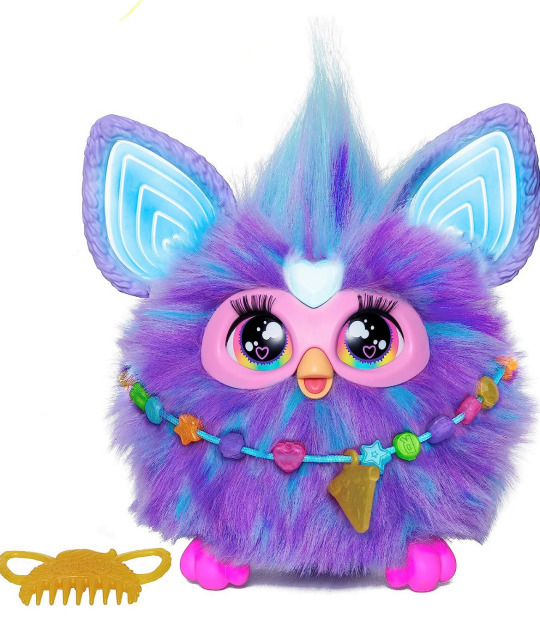
STOP INHUMANE FURBY BREEDING PRACTICES
#taikko talks 2 much#WHAT HAPPENED#im not that into the furby fandom but oh my god#i dont necessarily hate it with a burning passion and rage i just cant believe the difference between the old and new furbies#i dont like it and its not for me but that's about it#something about overly cute kids toys like these make me a little nauseous#back in the 90s things were cute but in the modest way it was simple living cute it was pleasing in the comforting way#cute things now are too hyper to me if that makes sense#things r too eye catching hyper cute instead of homey simplicity cute#or maybe thats just me idk#furby#furby love#furby 1998#furby community#furby fandom#furblr
907 notes
·
View notes
Text
BTS Reaction: You Wear a Revealing Outfit
Prompt: You wear a revealing/sexy outfit in front of the boys
Requested? Yes
Genre: Smut, Fluff
Word Count: 2.2k
Warnings: Suggestive Themes, Swearing
Female reader. Gifs are not mine!
Masterlist
_________________________________________
Kim Namjoon:
It honestly wasn’t too uncommon for you to wear clothes that were tight fitting or that showed off a bit of skin. You felt a lot more confident when you wore these things and you knew that Namjoon loved when you wore them as well. He never really had a problem with you showing off your figure a bit, since you did look good and he felt that you should wear what makes you feel comfortable. It had been a few weeks since you had really been able to spend time with your boyfriend and Namjoon finally got a night off so he figured the two of you could go out. He had gotten a reservation at your favorite restaurant and had bought you a new dress for the occasion. It was tight fitting to show off your curves and short enough that it barely touched your thighs. Pair the dress with your favorite heels and makeup and you were set to go. When Namjoon saw you walk into the living room he immediately ran his gaze across your body, drinking in every detail with a smirk. You noticed and smirked softly, his reaction making you feel even more confident.
“Like what you see?” you asked teasingly, causing Namjoon to smirk as well as he walked over to you.
“A lot,” he said as he rested his hands on your hips, pulling you over to him. You wrapped your arms around his neck and kissed him softly, which he eagerly returned. “Damn baby girl,” Namjoon growled when you pulled away, “I’m half tempted to skip dinner and rip that dress off of you.” You laughed softly and hit his chest.
“I did not get all dressed up for nothing, you’ll just have to contain yourself until we get home.” Namjoon hummed in thought as he buried his face into your neck.
“No promises.”

Kim Seokjin:
To Jin, you had always been his innocent princess. With your cute expression and oversized sweatshirts, (that were his 90% of the time). He loved that look on you, and it did always make you look small and innocent. You had never really worn anything that showed off your body. Not because you were insecure, but just because you found the baggier and larger outfits more comfortable. This time however, was a bit of a special occasion. This was the first award show that you would be attending with Jin and you wanted to look your best. Afterall, if you were dating World Wide Handsome, you had to look the part. You had gotten in contact with one of the stylists and she had helped you pick out a nice dress. It was floor length and not too tight fitting, but it was low cut and showed off quite a bit of your cleavage. You were a bit nervous to be seen with it, but it was too late to change.
You were waiting in the room for Jin to come and grab you so you could head out together, nervously playing with your hands. Jin had walked in a moment later, in the middle of greeting you but he stopped once he saw you.
“Jagi, what are you wearing?” he stuttered out after a minute. You frowned softly and looked down at yourself.
“Do you not like it?”
“No no I love it!” he assured, “it’s just, kind of revealing don’t you think?” He didn’t mind it at all, you looked amazing. However, given the thoughts that he was having seeing you in it, he knew others would have the same idea.
Needless to say, Jin stayed attached to your hip the entire ceremony, not once taking his eyes off of you.

Min Yoongi:
The one thing that Yoongi loved about you was the way that you dressed, since you wore what you felt comfortable in rather than trying to impress anyone. You weren’t the most confident in your appearance, so you tended to wear clothes that hide your figure. Yoongi knew this and, despite his constant assurance that you were beautiful, he never pushed you into wearing anything else. It was extremely hot out and your air conditioner wasn’t working so you were walking around the house in only short shorts and a tank top. Evidently, you hadn’t been planning on going out at all today or you would have worn something a bit more modest. Fate seemed to have other ideas though as Yoongi called you, explaining how he left his flash drive there and he desperately needed it in order to finish his work. His voice was stoic as usual, but you could still tell how frantic he was and promised you would be there in a few minutes, quickly grabbing the item in question and rushing out the door. You hadn’t realized what you were wearing until it was too late and you were already pulling up to the building. An annoyed groan left you as you looked for something to cover up but decided to just rush in there quickly and get it over with. Yoongi turned in his chair when he heard you entering his studio, smiling softly and getting ready to thank you before stopping himself upon seeing what you were wearing. You immediately felt self conscious and tried to cover yourself as you quickly walked over and set the drive on his desk, turning to leave when he grabbed your wrist and pulled you into his lap.
“Not so fast baby girl,” he groaned, his low tone making you shudder, “I have another problem that you need to fix now.” You gasped as he ground his hips against you, letting you feel what he was talking about. Maybe you would have to start wearing these things around him more often

Jung Hoseok:
Hobi had been trying to get you to try dancing with him for a while but you always had a different excuse every time. Not that you didn’t want to spend time with your boyfriend, but you weren’t nearly as good of a dancer as he was. Hoseok was persistent though and cornered you one day when he knew that you were free so you had no choice but to agree. Since it was fairly hot outside and you knew how intense some of his choreo could be. You decided to wear a top that showed off your stomach and sweatpants, tying your hair back so it was out of your face. At first, Hoseok hadn’t noticed the outfit that you were wearing, more focused on his excitement and teaching you the dances. It was only after the two of you decided on a short break that he finally took notice. You were covered in sweat which caused your already tight shirt to stick to your body, leaving very little to the imagination. Hoseok's breath hitched and he quickly looked away to try and clear his head before he got a bit too excited, the poses you were making not helping him either.
“Hey Hobi,” you called out as you stretched, “can you bring me my water bottle?” He nodded and quickly brought it over to you, still trying to keep his eyes from wandering to your chest. You hadn’t noticed his strange behavior and thanked him as you took a few drinks to help cool yourself down, a few drops slipping past your mouth and dripping onto your chest. The second he saw that, he caved and you quickly found yourself pinned against the wall with your boyfriend's lips roughly pressed against your own.
“You know Jagi,” Hoseok whispered when he finally pulled away, “that last dance was too easy, why don’t we try one thats a bit...harder.”

Park Jimin:
Like Jin, Jimin always thought that you were more cute and innocent. You always dressed up in the cutest outfits and you would always shy behind him at the smallest of sounds. He could never really see you as anything else other than his precious baby. It was the weekend and you were planning to spend the night out with your friends since Jimin was still busy with the new album. You wanted to dress up a bit since this night was supposed to be your time to let loose and have fun, but you also were worried about wearing something too extreme. Not that you owned any outfits like that to begin with since outfits that were a little tighter than normal tended to make you nervous. After rummaging through your closet for what felt like the millionth time, you finally settled on a skirt and a semi low cut tank top. It didn’t show off much, but it was still more than you were used to and it made you a bit nervous. You were walking out of your room to grab your things and head out when you heard a familiar voice in the living room. What was Jimin doing home? He said he wasn’t going to be back until late! You froze for a moment before collecting yourself and sneaking to the front door in hopes that Jimin wouldn’t hear you...he did.
“Jagi?” you heard his soft voice call as he got up and walked over to you, “are you going somewhere? I just got home and I thought…” he trailed off as he took in your appearance. “Jagi, what are you wearing?” You felt your face heat up as you stuttered over your own words trying to come up with an explanation, his gaze making you feel incredibly small.
“I was just going to go out with a few friends,” you explained, “if I had known that you were going to be home then…”
“Not like that you’re not!” Jimin cut you off, wrapping his arm around your waist and pulling you to him, “sorry baby, but you’ll have to call your friends and cancel. We have other plans now.”
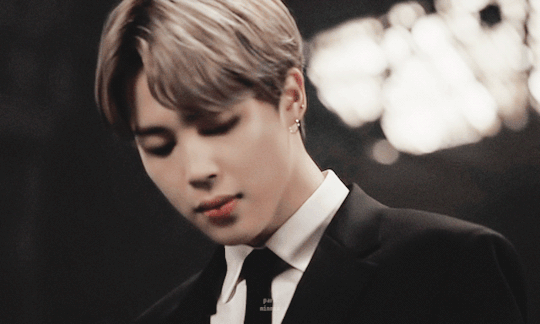
Kim Taehyung:
Taehyung had finally gotten some time off and the two of you decided to go out and spend some much needed time together. Since the weather was nice, you decided that it would be a great idea to go swimming together. It was fun, would keep you cool, and you had just gotten a new bathing suit so it was a win-win situation. The bathing suit itself was a simple one piece, but it was a bit low in the chest and had straps at the side which showed off quite a bit of skin. Taking a second to glance at yourself in the mirror, you smiled at the way the bathing suit fit you before jogging outside. Taehyung had clearly beaten you there and was already in the water when you walked over. He swam over to the edge and looked up at you with a bright smile, trailing his eyes over your figure.
“Is it hot out here or is that just you?” he asked, causing you to laugh as you carefully stepped into the water. Your boyfriend seemed to have other ideas though as he grabbed you and pulled you down, giving you seconds to react before you were fully submerged. Once you resurfaced, you glared over at him as he laughed, causing you to push him under as revenge. His arms wrapped around your waist and pulled you down with him so you were both underwater, crashing his lips against yours.

Jeon Jungkook:
It had taken Jungkook a while to not get shy when he was around you. He was definitely a lot more comfortable and confident around you, but he still managed to get flustered over simple things. The farthest that the two of you had ever gone is kissing and even that was barely more than a light peck. Whenever things started to escalate, one of you would get shy and back off. He had always found you attractive, but never really found the courage to act on it...until now. He had just gotten back from tour and decided that he was going to stop by your place and surprise you, being familiar with your schedule and knowing you would be home. It was your day off and you preferred to stay home and relax rather than go out anywhere. You had actually just gotten out of the shower when you heard someone knocking on the door, quickly scrambling to put on a robe and rushing to the door. You assumed it may have just been your neighbor or a delivery, so you were pleasantly shocked when you saw your boyfriend on the other side of the door.
“Kookie!” you exclaimed as you jumped into his arms, forgetting about the very thin fabric being the only thing separating your bare form from him. Jungkook surely noticed though, feeling his breath hitch as he cautiously ran his hands across your body.
“Wow,” he whispered softly, “I came over to try and surprise you and yet I am the one being surprised.” You were about to ask what he meant by that when you felt one of his hands trail down your back to squeeze your thigh, realizing now how exposed you were.
“Um yeah, let me go get dressed real quick,” you managed to stutter out, but his grip on you only tightened.
“Stay, I think I like this look on you,” Jungkook purred, “but I think I would like it off even more!”

#bts#rm bts#BTS jin#BTS jungkook#bts v#bts smut#bts jhope#kpop#KPOP idol#kpop fanfic#kpop group#kpop reactions#x reader#bts reactions#bts scenarios#bangtan#bangtan boys#requests#request#requested#jungkook#jeon jungkook#jungkook fluff#kim taehyung#kim namjoon#kim seokjin#bts namjoon#namjoon fluff#namjoon x oc#seokjin
287 notes
·
View notes
Text
Imagine Raising a Direwolf Puppy with Sandor
yall can blame @multifandommandy for this overwhelming fluff, this is 90% her masterminding 👀
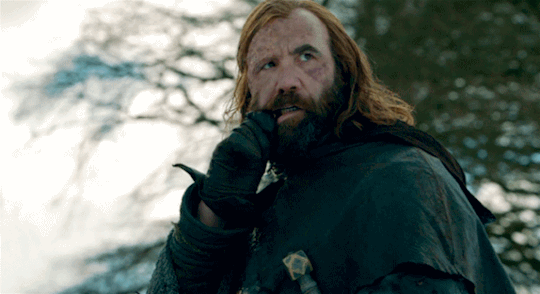
Some time ago, you had found the giant man bleeding out in a ditch. You’d been the one caring for him, and you both began to grow close as the months passed. Sandor ended up staying on your modest farm to help you out; you were alone since the war had taken your father and brothers. Even the townspeople had grown used to him, and the village more or less considered you two married. It’d been a few years since you were with Sandor, so you’d agree with that.
Your small farm was on the edge of the village, close to an overgrown forest. It was in these woods that you found a sad, mewling pup. There was no sign of mother or siblings, and it looked sickly. Stray dogs were not common in the woods … but you took it home anyway.
Sandor assumed it was a regular wolf pup and told you to take the damn thing back. It would probably die anyway. You said you’d feed and care for it until it was healthy to walk again, then you’d let it go.
“It’s a wolf, not a fucking bird! It’s a wild, mangy thing. Put it back in the forest.” “If I put you back in that ravine, you would’ve died. I’m keeping him.” “Don’t compare me to a squalling mutt that can’t even open its eyes. Ya should put the damn thing back, and don’t fucking name him.”
You named the pup. After a week, he finally got his energy back and was able to walk about and follow you around the farm. He was such a cute, fluffy thing, and so young. You figured he was abandoned by his mother for being so sick.
The pup loved being underfoot as you worked. You didn’t mind because you could easily avoid him, but Sandor cursed and probably almost broke his neck three times thanks to the wolf darting around. Once he growled at it so fiercely it went crying back to you, and you scolded Sandor for “bullying a baby”.
He sure ate a lot for his small size, and the teething was a nightmare. He chewed off an entire leg of the table (the crashing in the middle of the night alerted you to this), and he’d easily chomp through the bones you bought at the butcher. You started taking him to town for the latter, and the children delighted in petting him.
Seeing you holding the pup on a leash reminded Sandor of Winterfell, many years ago. He began to wonder if it really was a simple wolf you found. The children weren’t afraid of Sandor when he had the pup, and he’d endure them circling around to pet the wolf and ask questions while you bought some things.
You worried about how the pup would be with the chickens and the few goats on your farm, but he was curious more than anything. The rooster frightened him until he smacked the bird hard once, after that the rooster seemed content to leave the pup alone. He was curious about the chickens and after several months, they trusted him enough to let him lie down with them.
The goats were devils in white fur; they loved headbutting the pup, running off and bellowing when he was too clumsy to follow properly. Sandor encouraged the pup to just eat one of the damn things, you tried scolding the pup away from them and keep them all separated. If any goats went “missing”, you always assumed it’d be Sandor who did it - he hated the nipping, bleating things - but now there was a second culprit to consider.
When the pup was in the way and underfoot, you’d scold him or distract him, but Sandor had little patience for training. He’d just lift the pup and move him somewhere else. Sandor noticed that the pup was getting heavier, and you were having trouble lifting him at all (it didn’t help that he’d go limp if he really didn’t want to move).
The pup’s curiosity meant he had little fear. The exception was thunderstorms: It started with the whining, then the howling. You made him a comfortable spot in the barn, but you could still hear the howling from the farmhouse. Sandor didn’t tell you, but it was just like the howls that rang through Winterfell when that boy fell from the tower. It kept him awake, which was a good thing - he was there when the front door went crashing down. The wolf leaped from the front entrance to the bedroom, scaring the shit out of both of you. You had to hold the pup and soosh him while Sandor hastily fixed the door, cursing the wolf the whole time.
(When he got back to bed he pet the wolf with you, and kept doing so when you fell asleep. The pup finally went to sleep around dawn, snuggled up to his papa’s side).
Once he was older and more obedient, Sandor brought him along on hunts. The wolf was a natural, of course. He sniffed out trails with Sandor, alerted him to prey and chased after and caught more than a few rabbits. Soon it was fawns he was catching and bringing back. A few times around dusk, Sandor could hear wolves howling in the distance, and the pup let out a fearsome howl in response that did not suit his smaller body. Sandor figured it was just a matter of time before the beast was as big as a horse.
Whenever they’d come back from a hunt, you’d be there at the door to help Sandor bring it in, give him a kiss, then you’d (try to) clean off the pup’s muzzle and give him a kiss for helping. At the dinner table, you’d notice Sandor slipping bones and morsels to the pup.
“What’d you tell me about spoiling him, dear?” “He did most of the huntin’, woman, he deserves it.”
It wasn’t a year yet and the wolf was already far larger than any dog you’d ever seen, or wolf, for that matter. He was becoming protective, too, sometimes a bit too much. You stopped bringing him to town because he’d stare down any man that came near you - something Sandor insisted wasn’t a problem - and you worried about the children getting close. During the rare visits Sandor made, he’d bring the wolf, patting it on the head to relax it around the children and letting them give him careful pets.
Whenever he was working on this or that, the wolf would relax by Sandor’s side and happily accept the lazy pets on his ears and muzzle. Sandor had a chair he built inside the house, and he’d let the wolf sit up on his lap, even if it was getting way too big for this shit. Anytime you’d glance over them with a smirk, Sandor would scoff. “What, woman? He’s too damn heavy to move. Better to let him be.” “Yes, love, of course.”
Once it was a year old, maybe a little older, the direwolf began disappearing for long periods of time. Sometimes you’d hear wolves howling in the night, and that would be interrupted by an even louder, sharper one that would make you shiver. Sandor assured you that he was a wild animal, and he couldn’t always stay with the two of you, but he’d still wait up a while with you.
Whenever your direwolf came back after several days, he’d usually bring a gift of a fawn or even a chunk of deer … and leave it right on the porch. You’d open the door to a mess of blood and your pup waiting patiently, eager to see you, but knowing mama doesn’t like bloody paws all over her clothes. After a quick scrub you’d be happy to give him plenty of affection, and if Sandor was the one who woke up first, you’d find him scrubbing the wolf instead.
The direwolf no longer wanted trips to the village - not that it was safe - and he sometimes spent a day or two around the farm before disappearing into the woods for a week or ten days at a time. You’d always have meaty bones ready for him when he came back. And sometimes Sandor would come home with a deer and tell you the wolf just appeared before him, helped him hunt for a few hours, then went off on his own. You knew your husband missed him as much, since he was the one picking out the “best” bones for the pup.
Interestingly, you two heard from the townspeople that the direwolf would help other townspeople hunt, too. Sometimes he’d even appear when one of the children wandered too far, and would try to herd the child back. It seems every other visit to the town, someone would have some story to tell about “your” wolf. It was nice to hear about your sweet boy when you couldn’t see him, and you looked forward to when your four-legged “baby” would meet any two-legged children you had.
381 notes
·
View notes
Text
castles in the air | lee donghyuck | two
lee donghyuck x female reader
genre; enemies-to-lovers, friendship, romance, fluff, angst
warnings; mentions of alcohol and drinking in this chapter!
foreword; in which you might be a real-life princess with a prince promised to you right from the start, but you won’t be getting your happy ever after.
<< previous chapter | next chapter >>

You stand before your wardrobe, faced with yet another clothing dilemma. You love fashion and dressing up, you really do, but sometimes it can be a real pain in the ass.
If this were another soirée or evening function, you’d know exactly what to wear—that gorgeous Isabella Militao dress you’d been saving for a spectacular debut. That would be sure to make jaws drop; it was a gift fashioned by the loving hand of Aphrodite herself.
But you’re going to a high school party, and you don’t think girls turned up in the latest garb fresh off the runways of New York Fashion Week.
You think back to when Donghyuck asked you to go to the party with him (“because we actually need to seem like we’re dating”), and you asked him what to wear. He’d scoffed and you nearly socked him in the face.
“How would I know? Your parents literally own Seoul’s biggest fashion brand. And you’ll look good in whatever.”
If that had been a genuine compliment, you would have been flattered. But it was the tone in which he’d said it, that matter-of-fact, detached voice devoid of any tinge of personal belief or emotion that made it clear he was merely stating a truism, an indisputable fact. He might as well have said that the sky was blue.
You eventually decide on a red sleeveless silk floral dress that stops slightly above mid-thigh. It’s not exactly the most modest article of clothing you own, but it’ll have to do.
When you get in Donghyuck’s car, he doesn’t even glance over to see what you’re wearing, a stark reminder that this clearly isn’t a real date. You on the other hand, can’t help but sneak peeks at his outfit (it’s just the fashionista in you, you swear): a denim jacket thrown over a casual white button-up shirt and dark jeans. A simple look, but surprisingly he makes it work.
You quickly look away before he catches you staring.
He drives in complete silence and before long you reach your destination. Upon entering the house, Donghyuck immediately leaves your side to reunite with five other boys; you have to stand alone for a hot minute and bear witness to the fist bumps, back slaps and bro hugs going all around.
“Who’s this?” One of the boys asks, his blue hair gleaming underneath the faux strobe lights.
You open your mouth to reply, but Donghyuck beats you to it. “My girlfriend. Everyone, this is Y/N.” He sounds like he’s gritting his teeth while introducing you as his girlfriend, which makes you want to laugh; after all, he’s brought this upon himself.
“Hi,” you say, smiling at the boys, “it’s nice to meet you guys.”
“Hi, I’m Jaemin,” the blue-haired boy steps forward and says, flashing you a wide grin that sparks a curious flutter in your chest.
“Did you break up with Sohui?” A brooding, dark-haired boy asks Donghyuck. It’s clear to see that he has none of that chipper energy Jaemin possesses.
Donghyuck’s gaze becomes shifty and he clears his throat awkwardly before replying, “Yeah.”
What a lie.
Before you can think too much about it, Jaemin whisks you all away for a game of spin the bottle. The consequence? 7 minutes in heaven.
You’d heard of the game before but you didn’t think people actually played it at parties; it all seemed so terribly cliche. Looks like you were dead wrong, because once the bottle lands Jaemin and then you everyone’s in an uproar and you’re panicking because you really don’t want to lose your first kiss to a stranger, however hot he may be. Heck, you’d rather do it with Donghyuck; at least he’s a familiar enemy.
Jaemin smirks at you and grabs your wrist, gesturing towards a nearby closet (god, the sheer disgrace you feel, what would your parents say?) and your heart starts thumping in your ribcage, the butterflies from earlier entirely gone. You contemplate breaking out into a sprint for the bathroom or just running out to the garage and driving Donghyuck’s car away into the night. You look over at Donghyuck, hoping that he can read your mind and get you out of this situation (you know he hates you but surely he doesn’t hate you that much), but he’s staring at you with a glazed expression on his face and you can’t believe he’s about to offer you up like a lamb to the slaughter, that asshole—
“I’ll do it instead,” Donghyuck suddenly stands and grabs your free hand, tugging you away from Jaemin. Without waiting for his response he drags you behind him to the closet, pulls you in and shuts the door with a loud slam.
You release the breath you’d unconsciously been holding and start to sink down onto the cushions littered about in the dark, dank and cramped space, but then you stop short Donghyuck places a hand on your arm. He shrugs off his jacket and shoves it into your hands, whispering, “Your dress.”
When you two are finally seated, his jacket draped over your lap, you ask in a slight whisper, “What do we do now?”
At this, Donghyuck breaks out into a sardonic smile, leaning in close to whisper in your ear, “We’re not going to do anything. Don’t forget that I have a girlfriend, and if I kiss you, you might just fall in love with me. Can’t risk that now, can we?”
You try to ignore the way his breath tickles your ear and the fact that it’s not an entirely uncomfortable sensation. You hate the way Donghyuck plays with you like this, as though he’s constantly reminding you that he will never be yours, arranged marriage or not.
You press yourself into your corner of the closet to get as far away as possible from him, before taking out your phone and instinctively scrolling through Twitter, your lifeline—it’s almost like a coping mechanism, the way you try to get lost in your timeline filled with pictures of the Albertine bookstore and 90’s Chanel gowns to try and forget the fact that you’re currently stuck in a musty closet with your childhood enemy. Donghyuck does the same; he pulls out his phone and starts typing rapidly. You figure he’s texting Sohui to complain.
Before long the 7 minutes are up and the boys are pounding on the closet door. You sigh; they sound like ravenous zombies lying in wait to chew you out when you emerge. You’re about to push the door open when Donghyuck puts a hand on your arm; you turn to face him with the most annoyed expression can muster. What now?
Without warning, he reaches behind you and pulls out the scrunchie that’s holding your hair in a high ponytail. You nearly yelp at him in surprise as your hair spills past your shoulders, utterly dishevelled (also, that’s a limited edition Chanel scrunchie right there) but he must have seen it coming because he places his hand over your mouth, quick as a flash. Leaning in close, he whispers in your ear, “We have to look like we just made out, idiot.”
You flash him an angry glare which soon turns into a look of sheer embarrassment as he unbuttons the first few buttons of his shirt, a sliver of light through the crack in the closet falling on his now exposed collarbone. You look away hastily, thankful that the darkness obscures the blush creeping up your cheekbones.
He’s about to push open the door when he suddenly hisses, “Shit, I almost forgot the most important thing. I need to get some of your lip gloss off.”
Against your better judgement, you acquiesce. Anything to get out of this literal hellhole.
Closing your eyes, you feel a warm palm on the back of your head and you brace yourself. You feel his thumb running across your bottom lip in one swift but gentle motion, and when you open your eyes he’s swiping it across his own.
The blush in your cheeks intensifies and you look away quickly.
Finally, Donghyuck pushes open the door and a flood of electric purple light streams in. The boys whoop and cheer, and Jaemin invites you to sit next to him. You happily do so, desiring to be in the proximity of anyone other than Donghyuck—you might just combust with embarrassment if you sat next to him after that horrendous episode.
“Are you good at drinking, Y/N?” Jaemin asks, his smile as striking as his cobalt blue hair. He really is a heartthrob.
“Somewhat,” you say, being deliberately evasive; you aren’t about to let him know that your tolerance was limited to dainty sips of Sauvignon Blanc or Chardonnay typically served at the high-end functions you went to.
“Great! Let’s play a drinking game then,” he says, winking, and the butterflies in your stomach make it hard for you to resist.
Over the course of the next hour, you find yourself in an endless cycle of drinking games—you weren’t bad at those games, and it wasn’t very often that you had to drink, but when you did, the single shot of soju burned your throat on the way down and seemed to erode your consciousness along the way. You can feel your cheeks getting hotter and hotter, and the laughing faces of the boys seem to pass by in a hazy blur.
“Y/N,” a low voice chimes in your ear; it’s a stern, familiar voice. You frown instinctively; you have a pretty good idea of who it is, even if you can’t see him. “Stop it. You don’t have to keep drinking if you can’t handle it.”
You wave him off; there’s no way you’re drunk. “Who… Who said I can’t handle it? I’m no… lightweight.”
“Yeah… She seems to be managing fine, right Y/N?” Another voice, this one slurred and a little too mirthful to be sober. A flash of blue hair. It’s the cute boy, you think to yourself and smile.
“Enough,” the stern voice cuts in again, right when you are about to reach up and touch the boy’s hair, to see if it feels like cotton candy as much as it looks.
You feel an arm snaking round your waist, forcing you to stand up. Your head rests on something firm and solid; it’s almost comfortable, but you want to keep drinking. You have to prove that you can hold your liquor; you are Y/N, for goodness’ sake, and you can do anything you set your mind to.
But before you can open your mouth to protest, the world begins to spin and darkness swallows you whole; you have no choice but to fall into it without resistance.
—
This isn’t what Donghyuck envisioned when you decided to take you to the party.
He didn’t expect to have to get stuck in a closet with you for a whole 7 minutes. He didn’t expect you to get dead drunk while slobbering all over Jaemin. And he certainly didn’t expect to be hauling you on his back to the front step of your house and having to present your dismally inebriated form to your mother.
“I’m so sorry,” Donghyuck says, hoping he comes across as apologetic enough, “I should’ve taken better care of her.”
To his utter astonishment, your mother waves off his apology with a flick of her hand. “Don’t worry about it! I expected this to happen; Y/N has never been to a party without us before. I’m glad you were with her; god knows what would have happened to her if you weren’t there!”
Donghyuck resists the urge to chortle. What are you, a child?
“Could you take her up to her room please? I’ll get the housekeeper to run her a bath.”
“Sure,” he says, grimacing inwardly at the thought of having to lug your deadweight up four flights of stairs; thank goodness there’s an elevator.
He tries his best not to dump you unceremoniously onto your bed, taking care to remove your strappy sandals. When the job is done, he’s about to leave when something on your desk catches his eye. He walks over and picks it up, turning on your desk lamp for better lighting.
In his hands lies a framed photo of the two of you when you first met as kids—you in a bright pink dress adorned with a monstrosity of ribbons, him in a suit. You’re both sitting on a park bench holding hands; he’s staring at the camera with a stony expression, while your smile looks more like a grimace.
The memory of that day rushes to greet him, clear as day—it was the first time he saw you, and it was on the same day that it was announced that you were going to be his future bride. It was the day he started his campaign of relentless hate towards you, the day he decided that you were to be his lifelong enemy.
Donghyuck sets the picture down on your desk with more force than intended. Why would you still keep it? Did you really want a constant reminder of your betrothal to him? Did you really want a constant reminder of him?
His whirlwind of thoughts is interrupted by a weak voice. “Donghyuck?”
He walks over to your bed where you lie intoxicated, cheeks flushed and eyes half-lidded, tangled locks of hair strewn across your pillow.
“You’re awake,” he says, voice flat.
“I… said… I wasn’t drunk… idiot…”
Nope. Still wasted.
“Just go to sleep. Your bath will be ready soon,” he’s about to leave when you lift your hand to latch weakly onto his wrist.
“Wait,” you mumble, “I… have to ask you… something.”
“What is it?”
At this, your lips turn into a pout. “I know… you’re… a liar.”
“What?”
“You…,” you gesticulate aimlessly at him—after all, finding words is such a chore when you’re hardly sober— “when we were young… you said that… you hated me because I was wearing… pink.”
Donghyuck’s breath hitches in his throat; he can’t believe you can remember that.
“Yes; what about it?”
“You’re lying. That’s… a stupid reason… for hating someone. So tell me… why exactly… do you hate me so much?”
Donghyuck feels his heartbeat pick up but he keeps his lips pursed.
“I never told you this… but… it hurts. It hurts how… you don’t even want to be friends with me…” you ramble on, lips forming a pout while your eyelids get heavier and heavier. “Why don’t you like me…” Your eyelids flutter shut and your breathing evens, and Donghyuck releases the breath he’d been holding.
Donghyuck feels the sour pang of guilt creep up on him. Granted, you’d never done anything to warrant his hate for you; he simply detests your very existence, which isn’t something you can help. It never once occurred to him that you’d be hurt by him—he didn't think he mattered to you at all. He can’t believe you still remember what he’d said to you all those years ago. Sighing, he rakes a hand through his hair; perhaps some soul-searching is in order.
He pauses for a moment, watching the way your eyelashes graze your cheekbones ever so slightly. Your cheeks and lips are flushed cherry pink from all that drinking, and a stray lock of hair spills across your face. He reaches out to draw it away from your face, marvelling at how normal you look for once; your sleeping face is so tranquil, like a child’s. No one would ever be able to guess at how you are nothing less than a perfect, infallible human being. It’s easy for him to forget how you’re the same age as him; you just seem to possess a maturity way beyond your youth that Donghyuck really can’t wrap his head around.
He gently drapes the duvet over you, and he’s about to leave when he sees that his denim jacket is still wrapped snugly around your body, though it’s a couple sizes too large for your slight frame.
He can let you have it for a little while.
—
You proudly hand your mother your school journal, decorated with pink glitter and purple felt butterflies you painstakingly cut out yourself. On the first page, the words “My Dream Job” are neatly inscribed in cursive lettering, with hearts over the i’s.
“Mrs Lee asked us to write down our dream job today,” you gush, pigtails bouncing with excitement. “Look what I wrote!”
Your mother smiles as her eyes skim over the words ‘fashion designer’. You gabble on.
“I told the class I wanted to take over your company when I grow up and become a fashion designer just like you!”
“Very good, Y/N. I’m so proud of you. I have no doubt that will happen,” she says, patting the top of your head.
“Oh, I also asked Donghyuck what he wanted to be. He said he wants to be a singer when he grows up.”
Your mother’s hand falls from your head and she frowns. “Does he?”
“Yeah. Isn’t that cool? I told him that was really cool.”
Her expression turns austere. “There’s no future in that, Y/N. You should tell him to be like you and take over his family’s company. That way he’ll be successful.”
“But he’s good at singing,” you protest, eyes shining with the memory of his voice, “and he looks so happy when he’s singing. If he’s happy, won’t he be successful too?”
—
“Do you still sing?”
Donghyuck raises an eyebrow at you as he chugs his iced coffee. “Why do you ask?”
“It’s called making conversation. It might not be in our contract, but did you intend to sit in silence until the sun sets and we go home?”
It’s your turn to pick a date, so you’ve dragged Donghyuck to a music cafe with a stage by the entrance where a teenage boy sings soulful R&B tunes. You weren’t being entirely truthful when you told him you were just making conversation; you did want to know if he still sang. To see if he was prepared for what you were about to throw him into.
“Sometimes,” he says, “maybe one day I’ll serenade you. With a song about how annoying you are.”
You resist the urge to toss your steaming mug of chamomile tea in his face. These days, after your horribly embarrassing encounter at the party (Donghyuck insists that you threw up in his car, but you don’t remember that at all), his attitude toward you seems to have shifted. Sure, he’s still mean, but not resentful. He doesn’t seem to hate you that much anymore; when he says spiteful things you can sense its teasing undertones.
You wonder what sparked this change. Shouldn’t he detest you even more? You literally threw up in his car—or so he claims. Or maybe he’s finally come to his senses and recognizes just how lovable you are.
You load up your smile like a gun.
“You do that,” you say, raising your hand to beckon someone over. To Donghyuck’s surprise, the manager of the cafe scoots over, and when he leans down you whisper something into his ear. The man chuckles and sends a curious glance at Donghyuck.
“What was that?”
“Nothing,” you say, smiling sweetly and taking a sip of your coffee.
The performer ends the song, and bows to polite claps from the audience. The manager you just spoke to goes up on stage, voice filling the room.
“Thank you Jihoon, that was lovely as usual. Next up we have Lee Donghyuck—this is his first time performing, so do give him your encouragement!”
Donghyuck literally jumps in his seat and you stifle your laugh. He sends a death glare in your direction and mouths I’m going to kill you. You clap for him in response, that sweet smile never leaving your face. You’ll get it from him later, no doubt, but this is totally worth it.
Donghyuck finally gets up and trudges over to the stage. He steps up to the mic, closes his eyes for the briefest of instants, and his lips part.
You expected, after all these years, that his voice would have hardened somehow, taken on a rougher edge, flavoured with the accents of a baritone. However, Donghyuck surprises you yet again—his voice is just as airy and angelic as it was nearly a decade ago, and every line he sings is like a stream of honey pouring forth from his lips. He breezes through countless high notes effortlessly in a way that sends chills down your spine, without so much as a twitch of neck muscle; he loads every word with so much emotion that it seems like the euphonious melody is coming to life right before your very eyes. The other patrons in the cafe are spellbound, drinks and conversation long forgotten; he’s bewitched everyone, and there’s no escaping.
In short, Lee Donghyuck is still a marvellous singer. And possibly a siren.
When he’s done, it is silent for a moment, the aftereffects of his spell still lingering. And then a single clap from the manager breaks the reverie and soon everyone is applauding in awe and surprise. There are even a few cheers.
You watch as he smiles and bows bashfully before walking down the stage, leaving his five minutes of fame behind. His cheeks glow under the warm light of the cafe; he looks absolutely ethereal.
“What do you think?” He asks as he slides into his seat. You can almost feel the passion flowing from him in waves.
You stare at him, starstruck. How could you possibly tell him that you never want him to stop singing, that you actually would like to be serenaded by him, that you want to wake up and fall asleep to the sound of his voice every single day?
So you settle for, “N-Not bad.” Yes, you stuttered. You hope your cheeks won’t betray you.
Donghyuck smirks. “Really? Your face tells me something else.”
Instinctively, you place a hand on your cheek—it’s burning. You take a large gulp of coffee to hide the flames in your cheeks; Donghyuck’s smirk only grows wider.
Avoiding his gaze, you ask, “Anyway, what song was that? I’ve never heard it before.”
He rubs the back of his neck with his palm. “Actually, I wrote it.”
“You what?”
“I wrote it. Want me to announce it to everyone?”
You can’t believe it. Not only does this boy before you have the voice of an angel, he’s a lyrical genius too? The world is simply not fair.
“Wow.” You lean back in your chair, all attempts at unfazed composure gone. “That’s actually crazy. You’re actually crazy.”
You look back at Donghyuck, expecting him to look smug, but instead his lips are pursed and his gaze is downcast.
“What’s wrong? Upset that your identity as a secret genius has been exposed?”
“No, it’s just… I wrote this song for Sohui. I thought she would love it, especially since she’s always been super supportive about my singing and songwriting. But… she doesn’t like it.”
“Why?”
“I don’t know. She said I should have bigger dreams now. Apparently, I can’t get anywhere with this.”
You keep silent, wondering how she could possibly say that to him. Heck, if a boy wrote you a song and serenaded you with it you’d probably get down on one knee and profess your undying love to him.
“Maybe… maybe she’s right. My parents say that all the time too. I shouldn’t be singing anymore. It’s time to grow up. You can’t make money out of dreams.”
He looks so crestfallen, the incandescent shine that had previously graced him completely vanished. That shine of passion was what set him ablaze and made him look so euphoric, and now it’s gone, like a candle snuffed out by the darkness.
You want to get it back for him. You want to see that look of pure bliss spread across his face. You want to see him shining bright and luminous again.
“So, what? You’re just going to stop singing then?” You ask, folding your arms across your chest, “I thought you were more determined than that. Once you’d set your mind on something, you wouldn’t let it go. That’s how you nursed that burning hatred you had for me, right?”
He has the good grace to blush.
You lean across the table and look him straight in the eye. “And I thought you could care less what others thought; that’s why we’re doing all this. That’s why we’re going against our parents’ will and fighting this bloody engagement. The Lee Donghyuck I know won’t go down without a fight, especially if it’s something he clearly loves so much.”
One final push. “But I could be wrong. I mean, I don’t really know you.”
Donghyuck’s head snaps upward and he stares right at you; you can see the fire in his eyes. Whether it's rage or passion, it doesn’t matter. You managed to rile him up. That was all you wanted. That’s the only way to keep his flame burning.
—
The drive home is filled with a pregnant silence. You wonder if you took it too far; after all, you and Donghyuck aren’t exactly the chummiest of friends. Maybe you overstepped the boundary a little.
But all you know is that you won’t stand by and let him give up such a blessing, something that clearly gives him so much joy. You won’t let him become an empty shell.
You of all people know how that feels.
When you reach home, you unbuckle your seatbelt and say goodbye. “Thanks for today, Donghyuck. You can choose the next date.”
You’re about to reach for the door and get out, but Donghyuck stops you with a hand on your wrist.
“Y/N,” he says, and you look at him, acutely aware of the sensation of his fingers clasped around your wrist. His gaze burns into yours in a way that makes your heart jolt and your brain question everything you ever thought you’d felt about him.
You wonder whether, in an alternate universe, things could have been different between you two.
“Thank you,” he finally says, gaze softening, the faintest hint of a smile etched on his lips.
Perhaps you melted a little.
#lee donghyuck#lee donghyuck imagines#lee donghyuck scenarios#lee donghyuck fluff#lee donghyuck angst#nct dream#nct dream fanfiction#nct dream angst#nct dream fluff#haechan scenarios#nct haechan#haechan nct#haechan fluff#haechan fanfic#haechan fanfiction#nct scenarios#nct fanfic#nct fanfiction#nct imagines
85 notes
·
View notes
Photo
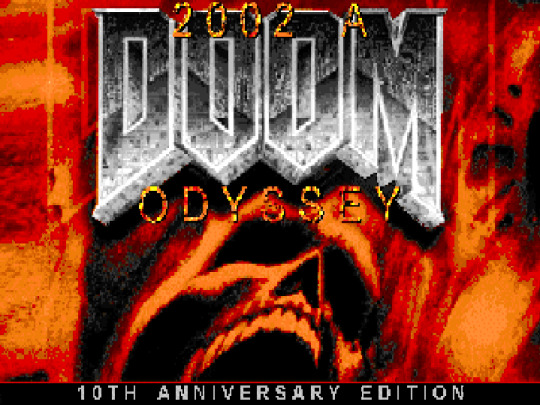

2002 A Doom Odyssey - 10th Anniversary Edition
Ultimate Doom megawad by various authors, spearheaded by Paul Corfiatis.
2002 (original release) 2012 (10th Anniversary Edition)
https://doomwiki.org/wiki/2002_A_Doom_Odyssey
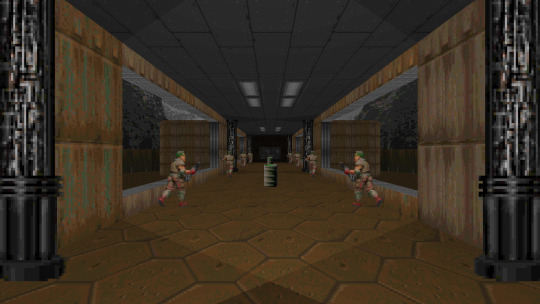
E1M1: The Entry by Paul Corfiatis
The introduction to this iconic Ultimate Doom megawad starts with a solid small map that reveals the flow and vanilla visual style as well as the theme of the big project. This is a small map with a good, charismatic and fun progress system that makes use of small groups of enemies and scene variation. 3/5

E1M2: Helicopter Bay by Kristian Aro
We continue our adventure through a nice and simple map that traps us in tight corridors with varied enemies and a good flow of combat as well as a variety of secrets and areas to explore. 3/5
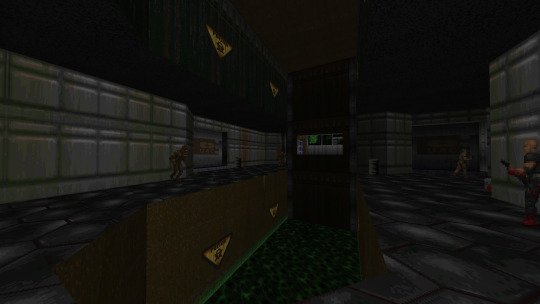
E1M3: The Doomed Lab by Paul Corfiatis (Exit to secret level)
Larger than the previous ones and with a well-defined combat in traps and varied encounters in corridors. The lighting is noticeable and a good general design of the level gives a nice feeling of progress through a classic tech-base. 3/5
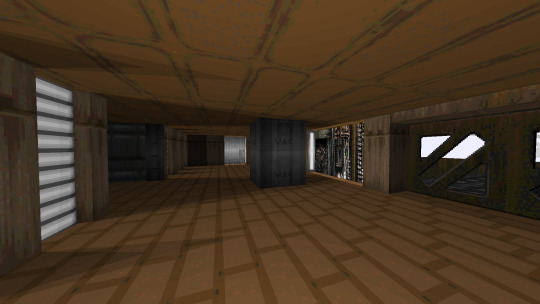
E1M4: Substation 537A by Kristian Aro
Fantastic map that seems to be clearly inspired by the style of the first maps of the original E1. A collection of connected corridors with different areas that set up intense combat zones at all times, as well as a few dangerous surprises with barrels. 3/5

E1M5: Combat Station by Paul Corfiatis
A much larger map than the previous ones with a variety of scenes and a high amount of teleporting enemies. This map stands out for its use of acid as well as its textures that scream 90s style in all its glory. Combat tends to focus on standing in a certain area and attacking you until the wave of enemies ends, giving some emphasis on survival and the search for secrets. 3/5

E1M6: Toxic Treatment Plant by Kristian Aro
This is one of those maps that sticks to a visual theme and succeeds in achieving it successfully. As the title indicates, this is a medium sized map with a design focused on industry and toxics. The variety of areas are connected to each other in a thematic way creating a sense of realistic narrative quite appreciable. Combat focuses on filling different areas with a variety of enemies, usually next to plenty of barrels of toxic waste. The crate storage area stands out visually and thematically on this map, offering something different and welcome. 4/5

E1M7: Service Base by Paul Corfiatis
More in the same style as HUB-arcoiris but with an excellent variety of areas to explore and interesting encounters in each meter we advance to reach each key. I like the idea that the map is in the heights, giving a great feeling of dreamlike design in the scenes where we can find windows. The dynamic combat is enhanced in the way it is presented in each area to get the keys, and that coupled with one of my favorite MIDIs make this a great map. 4/5

E1M8: Paradox by Kristian Aro
What is an E1 finale without a map with Barons as the final battle? Well, while in the original we have 2, here we have a good group of Barons to fight. The map starts with a cool intro that alternates the tech-base style to the classic Hell of Doom, and then introduces us to the final battle in a cool arena full of detail and sweet visuals. 4/5
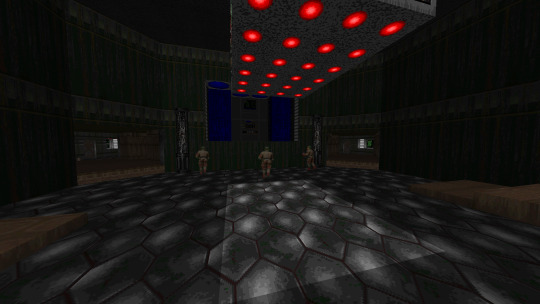
E1M9: Lugano Base ZR-X by Paul Corfiatis (secret level)
We heard you like tech-base, so we put more tech-base inside your tech-base so you can play tech-base. Basically this map and this episode, but that doesn't mean it's bad. This is a sprawling hub style map that throws huge amounts of enemies at us in blobs to create satisfying meat and gore combat. Variety of large areas with height give us plenty of room to have fun on a little odyssey through this new/old tech-base. Nothing special like a secret map, but fun. It is worth mentioning a swastika in the blue key room, I guess a reference to Wolf3D. 3/5
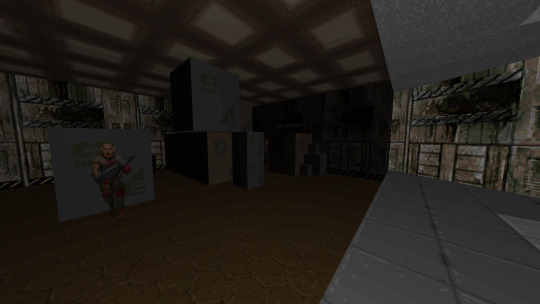
E2M1: Station Alpha by Paul Corfiatis
The small box store starts the introduction of the E2. This is a small map with a simple layout that, like the author's previous maps, follows a classic and understandable Hub system where we will go around several paths while capturing the necessary keys. The number of enemies has increased slightly, as well as the challenge, so we can say that things are going to get hot. 3/5

E2M2: Station Beta by Chris Hansen
The perfect blend of tech-base with a little bit of corruption. The atmosphere of the map stands out thanks to its excellent use of vanilla textures and attention to detail, evoking a sense of abandonment and desolation at all times. Coupled with a moving gameplay and a large amount of gameplay thanks to the use of various enemies, this is a fun map that takes us through a deep base from top to bottom. Cool, fun and beautiful. 4/5
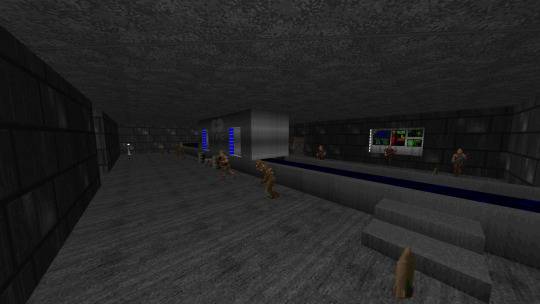
E2M3: The Lost Labs by Rory Habich
Tender medium map with a fairly clean style that seeks to create a technological atmosphere with a bit of progressive storytelling. This map takes us through long corridors as we take on a few enemies. Lost Souls dominate the map, as well as the color blue. Overall, it's a simple, modest, cute map. 3/5
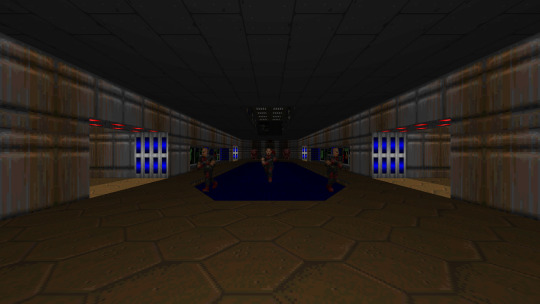
E2M4: Shotgun Blues by Paul Corfiatis (Exit to ZDoom bonus level E5M1)
What appears to be a small level at first, hides much more than meets the eye. The development of the map is revealed as we advance deeper through its intricate corridors and open spaces. It combines excellently well the styles of tech-base with hellish fortresses and even forgotten caverns. With a multitude of teleporter traps, combat is unleashed arena-style, including varied combat scenarios throughout the duration of the map. With 10 secrets in total, this is a map that cries out for you to explore, although a large majority of the secrets are so well hidden that you'll probably need a guide to complete it. Luckily, if we do this we will be rewarded very, very pleasantly. Overall, it's a fun and fantastic map to explore. The secret areas are worth it. 4/5

E2M5: Fortress of Fatalities by Paul Corfiatis (Exit to secret level)
I have a special place for classic map fortresses. As we can see, this is a map designed around the idea of creating an infernal fortress. The design focused on establishing a solid blend between the palpable architecture of the brick hell along with a bit of flesh corruption, creating a nice theatrical environment that works as a nightmare scenario. Combat unfolds on the basis of different fixed scenarios, usually near the keys, being these areas guarded by high amounts of demons that sometimes work in waves. In itself, its charismatic design and my weakness for fortresses make me feel obliged to say that I love it. It is good. 4/5
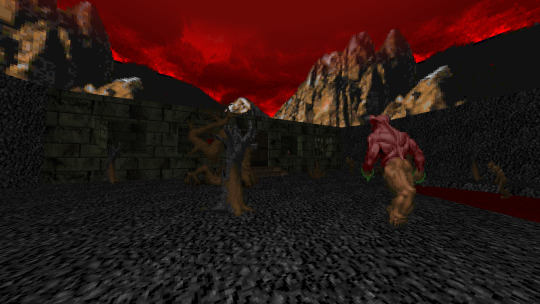
E2M6: Between Demons and Insects by Rory Habich
We start in a small room with two paths that slowly but dynamically reveals the rest of the map, until it evolves into a long odyssey with a huge amount of demons to kill. Excellent scenery variation and intense combat make this a pretty hot map that raises the difficulty expectations as we advance in this challenge. Near the final area we will find an interesting zone with teleporters and a long fight against a multitude of demons. 3/5
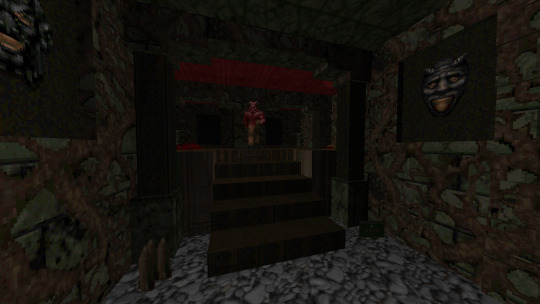
E2M7: Puzzles to Solve by Kristian Aro and Paul Corfiatis
If you were expecting puzzles, well, I'm sorry, the truth is that there aren't any. This map is more like a kind of puzzle pasted together, giving a discordant idea of design that manages to work thanks to good detail decisions and texture work, giving opportunity to tasteful fights that develop pleasantly around the entire map. 3/5

E2M8: Total Disturbance by Paul Corfiatis
We end the second episode with a nice and decent boss map, as we can expect. The introduction to the map is a fantastic way to set the mood and hype towards the final battle, to reveal a huge arena with a holy natural pool and towers surrounding it, as well as Cacodemons and our illustrious Cyberdemon. I like it. 3/5
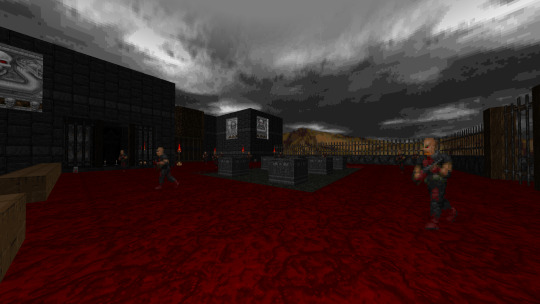
E2M9: Dungeon of Hate by Paul Corfiatis (secret level)
Excellent secret map with Heretic's visual theme. Lots of traps from the start and a few unexpected tricks that give it a great aura of mystery and precuation in every step we take. With well designed combat, pure power and violence, as well as great overall architecture and layout design, this is one of my favorite secret maps. 4/5

E3M1: Gatehouse by Sam Woodman
A beautiful entrance that opens to a hellish corner. This small iconic map marks the beginning of the third episode with an excellent demonic touch thanks to a detailed architecture in a simple and small layout that sets a good rhythm of movement. Dynamic in terms of presentation and fluid in terms of combat, it's a great level with sweet touches of lighting and good design philosophy. 4/5

E3M2: Caves of Bosnia by Paul Corfiatis
Deep and full of atmosphere. This map pleasantly complies with the visual design, creating a hellish level with excellent design touches that manage to capture that atmosphere of sin. On the one hand, the gameplay jumps back and forth between fun and tedious. The traps and scenarios do a good job of the combat, but there's an obscene amount of Lost Souls that do nothing but halt our progress and make us waste ammo. 3/5
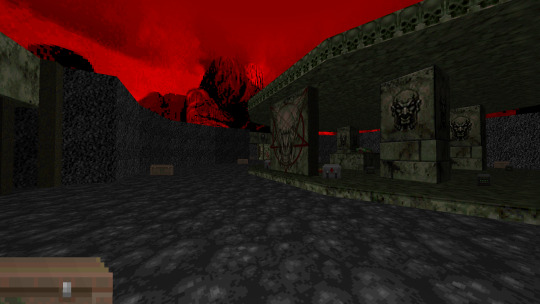
E3M3: Stronghold of Damnation by Rory Habich
With an open-ended style that has us go on a quest for keys to slowly progress through the map, this level has a good sense of direction and progress, as well as a chaotic gameplay that is fun and challenging without being tedious and annoying. The earthly design with demonic architecture gives it an interesting and attractive touch reminiscent of E4, with good detail in terms of small monuments and actions that give it a nice touch of challenge. 4/5

E3M4: Hall of Ebola by Rory Habich
Yes it is a hall, although I don't know if there is ebola. This is a hub style map with many paths and many doors designed to give you a fairly tight combat, which stands out for being designed based on monster-closets and many, many teleporters. The charismatic design and little extra details give it a nice touch, although the gameplay will make it turn red pretty quickly. 3/5

E3M5: De-Moon Side by Vick Bobkov
Welcome to a new infernal fortress. This map leaves no loose ends and gives you a quick definition of what's to come thanks to its tetric entrance. A large design with a square layout offers plenty of places to explore plus intense and tight combat with a few surprises that add some spice to the flavor. A final fight with a surprise gives it a different twist, giving it a certain appealing style of combat. Too bad there are so many Lost Souls. 3/5

E3M6: Obituary Written by Chris Hansen (Exit to secret level)
Interesting map with some small puzzles that give a touch of adventure to your strange exploration. The layout can be a bit inflexible at times, but it has an attractive design and a punishing combat that will make us pay attention at all times, especially for the fact that much of the map is in damaging floors. 3/5
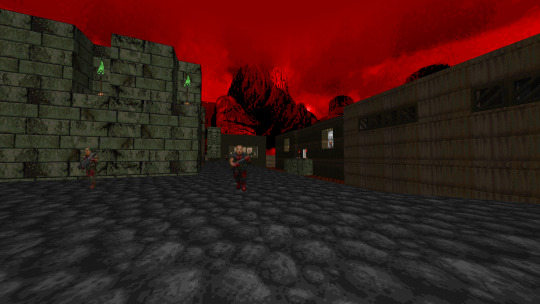
E3M7: System Central by Paul Corfiatis
If you missed the tech-base, here's a little something for everyone. This map combines the architecture of hell with the classic Martian tech-base, creating a strange but attractive discord that works under its own standards. With a great layout and a multitude of interconnected paths, the map works pretty much on the basis of a lot of backtracking, but usually releases a few surprises along the way to keep us from getting bored with it. A nice reference to E1M1 on the blue path can make our day. With an explosive gameplay that is dedicated to surprise us with a multitude of surprises and quite a few Cacodemons, it can be a bit challenging at times so you better have good aim. Or autoaim. 4/5
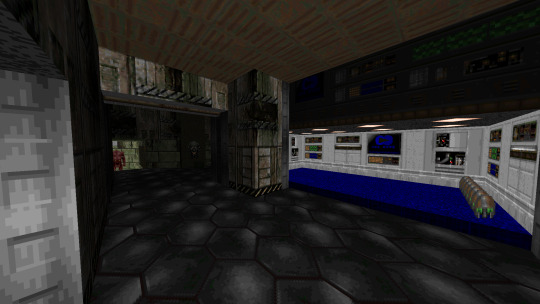
E3M8: Spider Temple by Paul Corfiatis
The end of the episode sees us traversing a small map but with a vast amount of exploration areas filled with small groups of enemies to end in a grotesque boss climax. 3/5

E3M9: The Lost Chord by Sam Woodman (secret level)
The secret map of this episode is a small but intense map with an attractive and modest design to the eye. Based mostly on speed and fluidity, the map follows an almost linear path through an intense battlefield with enemies in high density. This map, if played well, works as a good resupply point. 3/5
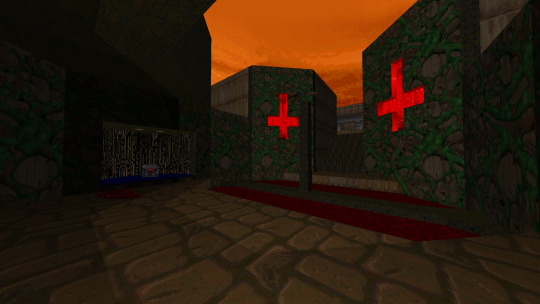
E4M1: Play School by Paul Corfiatis
You can't start episode 4 without introducing the iconic orange sky and the pure attrition difficulty. This is a small map with solid visuals that weaves itself into an interesting backtracking through an evolving map, with good (and hard) gameplay that emphasizes tactical decisions and ammo conservation. The start can be a bit rough if you don't know what to do right away, but with a few tries the map becomes easier and more fun. This is my favorite type of map. My kink. 4/5
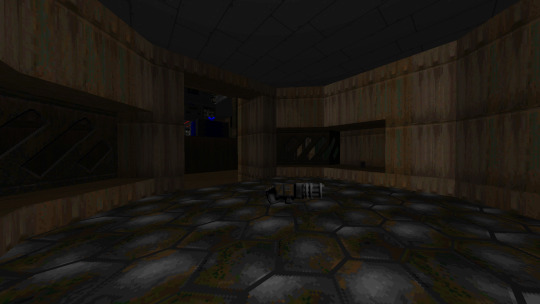
E4M2: Back to Base X by Anthony Soto (Exit to secret level)
A brown base that vaguely reminds me of Quake. With hidden corridors and dark atmosphere thanks to the good use of lights, this map is designed to give us constant and effective combat thanks to good construction of the setting and unexpected traps at times. 3/5
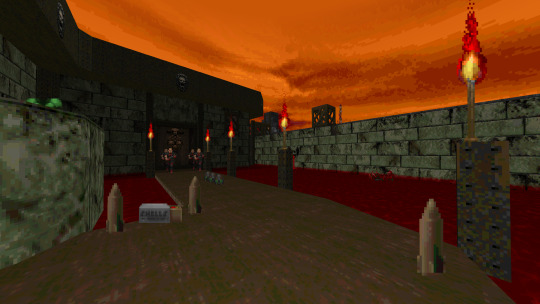
E4M3: Hell Unleashed by Chris Hansen
The title honors the challenging map. With tight corners, little room to maneuver and a multitude of traps, including an inescapable invisible trap that I'm not a big fan of, this map leaves no loose ends and throws everything at us in terms of difficulty. The attractive and simple design gives a sense of home thanks to the enclosed and diverse complex, but add in the bloody combat and the result is a home of pain. An interesting design that is somewhat obfuscated by a relatively unfair difficulty. 3/5

E4M4: Disreputable Stronghold by Chris Hansen
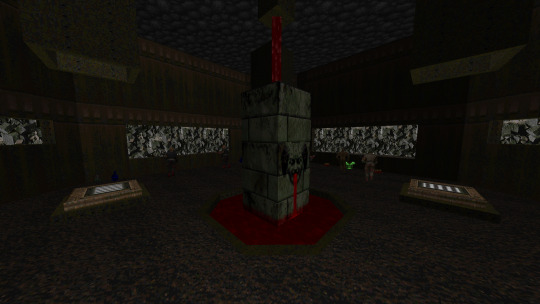
E4M5: Indomitable Haunt by Chris Hansen
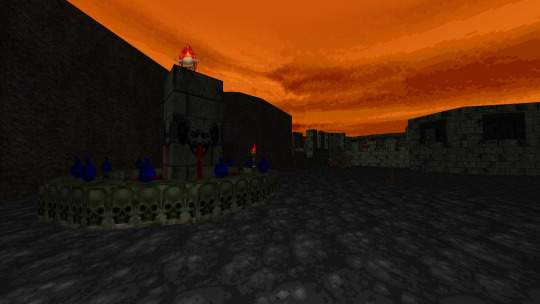
E4M6: Dementia by Joe Pallai
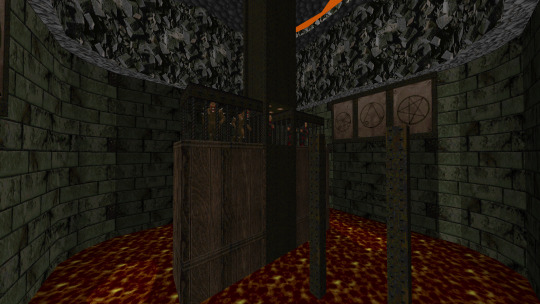
E4M7: Odious Grounds by Chris Hansen
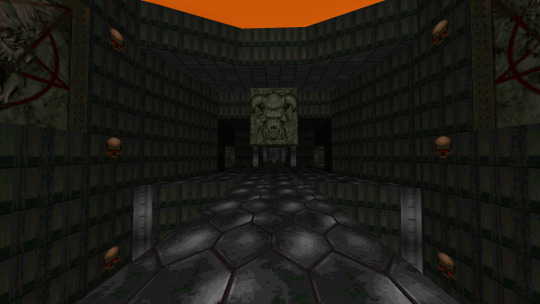
E4M8: Impossible Mission by Paul Corfiatis

E4M9: Secret Wolfenstein Level by Paul Corfiatis (secret level)
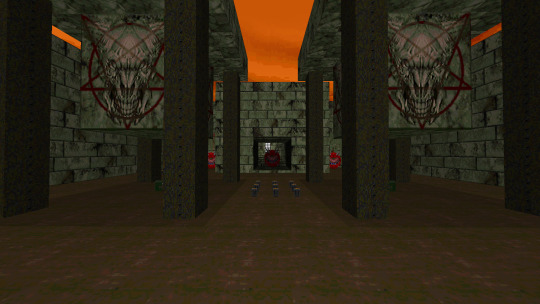
E5M1: The Mighty Green by Paul Corfiatis (E2 secret level, exit back to E2M5)
2 notes
·
View notes
Text
Oath of the Gatekeep
In my recent call for article requests, there was one in particular that merited some real follow-up on. @hopelessly-vorthosian posed the following:
I sometimes hear talk about Vorthos gatekeeping. Could you expand on that? How can more recent Vorthoses prevent becoming gatekeepers in the future?
That’s a really good question, and something I’ve wanted to tackle for a while.

Gatekeeper of Malakir by Jason Felix
What is Gatekeeping?
The most useful definition for gatekeeping I found was on Urban Dictionary:
When someone takes it upon themselves to decide who does or does not have access or rights to a community or identity.
So what does this actually mean, in a practical sense? I haven’t really talked explicitly about gatekeeping here, but a major reason why I started writing Vorthos articles was to avoid that gatekeeper mentality. To make things as accessible as possible. When I was first exploring Magic’s lore, many (not all, but even a handful feel like a lot) of the old timers were… less than friendly to new blood. The Mending had just happened and the popular derisive term of the day was ‘Bradywalker’, for the new kind of planeswalkers that had just become the status quo. If you weren’t a veteran of the Phyrexian Invasion, you weren’t a real vorthos.
So why is this such a bad thing? After all, if you were really in to a thing, you’d consume as much of it as you could, right? Well, my early interactions kept me from engaging in older Magic lore for a long time, and I focused pretty much exclusively on post-Mending stuff because I was so put off by that attitude, and it felt like if I didn’t read every old novel my opinion wouldn’t matter, anyway. Their gatekeeping actually pushed me away from the things they prized. If I’m honest with myself, a lot of my impressions of the older lore are still colored by their attitudes. I’m sure it’s the same with a lot of other people, both when it comes to playing the game and catching up with the lore. There has been plenty of discussion about how gatekeeping is a problem for the game itself, I’m just focusing on the lore, here.
Gatekeeping is self-defeating. It creates a culture of elitism, where the real fans (however they define it) are the true inheritors of the lore, and everyone else is a pretender. It also almost always ends in a culture of entitlement, where they believe they’re more deserving than others because they’ve been around longer, or have dedicated themselves more. Except, alienating an audience that could help keep what you love alive is just counterproductive.
Vorthos Gatekeeping
The Magic community is especially susceptible to gatekeeping for a wide variety of reasons. Nerds are by no means the only people who act like gatekeepers, but there’s something about the nerd or gamer identity that has a real resentment toward outsiders getting involved in interests that were once exclusive. It’s why women have to face “Oh, did your boyfriend bring you?” at Magic events, as if they couldn’t really be interested in Magic. And it only takes a handful of those Gatekeepers to create a toxic environment.
The other issue is that gatekeepers aren’t bad people, and they frequently don’t mean to be gatekeepers. I’ll be the first to say that I’ve been guilty of gatekeeping people in the past. Not necessarily for Magic, but for other interests. So how can we avoid it?
There Is No Wrong Way To Vorthos
I actually talked about this a bit way back in Magic Lore 100: Jargon, but it bears repeating here:
The term Vorthos came about with the article Snack Time with Vorthos. It was followed up on in Melvin and Vorthos and then Vorthos and Mel.
Essentially, a Vorthos is anyone who cares about the story, art, flavor, or lore. There is no wrong way to Vorthos! If you only want to follow the story through the pivotal moment cards, that’s okay. If you want to dedicate yourself to the minutia of every article, that’s okay too. If you love the artwork and want to rave about it, but don’t care all that much about the specifics of the story, that’s also okay.
Ant Tessitore breaks down this concept even further in his excellent article Vorthos 2015.
Someone who hasn’t read every Magic Story ever is not less of a Vorthos than someone who has. Someone who just loves the art and pays only a modest attention to the story is still a Vorthos. There is no wrong way to enjoy Magic, and when someone wants to engage in their interests, be supportive, not detracting. Even if their preferred way to vorthos is incessant color pie questions (I realize I’m a jerk on this front).
Be Supportive
No one should have to endure abuse to enjoy something they like, and most people simply won’t. A bad experience or two and they’re done engaging (and who could blame them?). This one of the major reasons I started writing vorthos content, because no one should just be told “Read the Wiki” when they have a simple question (note: I direct people to the wiki sometimes, but always to the appropriate page).
It also means that you shouldn’t be ‘Well, Actually’-ing people all the time. People are allowed to be wrong. It’s perfectly fine to correct people, but the way you do it matters. Last year, I commissioned my friend Jorge Velez (@kaigetsudo) to create this Planar Rangers design for a T-Shirt campaign. It’s awesome, right? Except, 90% of the comments I heard about it were “Where’s Liliana?”. The Vorthos community has a lot of passionate artists, cosplayers, and fanfiction writers that help keep it vibrant and alive. But when all you can say about them is how they’re not 100% canon, you again discourage people from engaging.
Be Conscious Of Your Words
This point is twofold. If you’re correcting someone, make sure you’re wording yourself to be understood. Starting off with “That’s wrong!” is obviously a red flag, but it can be hard to understand intent over the internet. Be clear with your words, small things like excessive punctuation and the lack of “I” statements can give someone a very different impression than what you mean.
It also means that you need to be careful what you’re saying, in general. It only takes a few people to give the impression a forum or website is toxic. If someone wants to engage but half the posts they find are you talking about how Doug Beyer personally broke into your home and kicked your dog, they’re not going to.
Learn To Let Go
This one is probably the hardest for people to change, but also the most important. “Bradywalker” and “Jacetus League” were cute the first couple months following their introduction. They’re significantly less so two or more years later. It’s okay if something changes in a way that doesn’t really appeal to you. It’s okay to voice your displeasure. But it’s not okay to harp on it for years, especially when you’d be better served moving on. If all you have to say is that Wizards is spitting on the graves of your ancestors, rather than sticking with it because of the sunken costs of your own time and nostalgia, consider just moving on.
This was by no means a comprehensive essay about gatekeeping in the Magic community, but I hope it gives everyone an introduction to what gatekeeping means in the Magic community.
199 notes
·
View notes
Text
Going up against a legend again in Gran Turismo Sport • Eurogamer.net
Stop me if you’ve heard this one before – and I’m sure you have, as it’s the only claim to fame I’ve got – but back in the early 90s I had a brief, unsuccessful and only mildly remarkable career as a young racing driver. It was remarkable mostly for who I raced alongside, because the kart tracks back then were the proving grounds of what would become a golden age of British talent. There were the likes of Dan Wheldon, Jenson Button, Justin Wilson, Anthony Davidson and Mike Conway to name a few, though to say I went wheel to wheel with them might be overstating it a bit. I’m not sure any of them ever noticed me while I toiled at the tail-end.
There was one driver I got to properly race against, though, just as he was starting out. We were novice drivers, racing – as the rules dictated – at the back of the field, which would soon prove to be my natural habitat. Still, I came in to the race in Rye House’s winter series off the back of a class win, so I was as confident as I’d ever been – confident enough to be taken aback at the young kid who outbraked me heading into The Esses in the dying moments of the final to take this particular class win. As a veteran of some three races I went to go and offer congratulations and some sage advice after the race. “You’ll do alright,” I patronisingly said as I shook his hand and his dad packed their kart away in the background.
You’ve probably already guessed, but that kid was Lewis Hamilton, who went on to do more than okay. I liked Lewis back then – he was sweet and humble and from a more modest background than most drivers at the time – and while we’ve not met since that one encounter back at Rye House I like him even more now. His six world titles don’t tell half the story, really, his greatness unsullied by the unsavoury tactics often employed by Senna and Schumacher, and all achieved in the face of persistent prejudice.
All of which might explain why the Lewis Hamilton challenges that cropped up in Gran Turismo Sport late last year have become an obsession these past few weeks. It’s a cute bit of DLC that manages to leverage the star appeal of one of the world’s most recognisable sportspeople, and it presents a pretty sizable challenge at that. The premise is simple: Lewis has laid down some laps, and all you’ve got to do is beat them. Or at least come within a couple of seconds of them.
youtube
It might not be the most elaborate of add-ons – it sounds like Lewis recorded his lines when he was in a rush to get elsewhere – but it does have that veneer of authenticity that’s always been one of Gran Turismo’s strengths, and it plays to a part of driving games that’s always appealed to me. If you want to get to the heart of any driving game, just take one car, one track and a ticking clock. The rest, quite often, is magic.
The challenge put up by Lewis Hamilton’s times in Gran Turismo Sport puts all that into sharp focus. This guy is seriously quick, and I’ve spent every spare moment I can the past week flailing in the shadow of his ghost as it tears around Brands Hatch’s GP circuit. I’ve not come too close, but I’ve learnt an awful lot along the way – indeed, despite having run countless laps around the Kent circuit before, across various games as well as over half-a-dozen or so track days in the past this is the first time I’ve been really pushed to learn Brands Hatch. And it confirms the suspicions I’ve had all these years that this really is a special circuit.
It’s a place where most apexes are hidden just beyond the crest of a hill, where the run-offs are just as often blind and where nailing any given section feels so damn good. There are corners in this world, and then there are the likes of Paddock Hill, Hawthorn, Sheenes and Surtees – fizzing blends of camber and undulation that still find ways to surprise and unnerve no matter how many times you’ve run them. Gran Turismo Sport is so beautifully faithful to all this, and to the challenge they present.
And so I’m chasing down Lewis and learning so much. Like how much speed you can really take into Paddock Hill and Hawthorn, how greedy you can be with the exit run-off at Graham Hill, how to lean into the camber of Stirling’s and how to finally make sense of Surtees, the left hander that curves out of sight as it leads out into the woods and the Grand Prix Loop. But still, I’m nowhere near him.
I look for help elsewhere, meeting up with a friend who’s become similarly obsessed. We meet for lunch at Lewis’ recently opened meat-free restaurant Neat Burger on Regent Street – of course – where he tells me about trail-braking, about famed driver coach Rob Wilson and his flat car theory. Those principles help – that night I pull the racing seat out again and spend another hour or so shaving away tenths, inching closer and closer to Hamilton’s ghost.
I still haven’t quite caught up with it, but it’s made me appreciate Gran Turismo Sport that little bit more – appreciate how effectively it’s blurred the edges between the real and the virtual, how its handling embraces all-comers while allowing the application of some hard-edged racing principles, and most of all how it’s allowed me to face off against one of motor racing’s all-time greats. And it turns out Lewis Hamilton is very, very good at driving cars. At least I got one thing right all those years ago. He ended up doing just fine.
from EnterGamingXP https://entergamingxp.com/2020/02/going-up-against-a-legend-again-in-gran-turismo-sport-%e2%80%a2-eurogamer-net/?utm_source=rss&utm_medium=rss&utm_campaign=going-up-against-a-legend-again-in-gran-turismo-sport-%25e2%2580%25a2-eurogamer-net
0 notes
Link
Prune is a tiny mobile game about the simple pleasures of growing and cultivating trees.Of breathing life into barren soil and thriving against all odds in a hostile, indifferent world. It’s a delicate dance to remove that which does not matter in favor of that which does.
Prune is my love letter to trees.
The seed of the game (first and last tree pun, I promise!) actually started with a tweet from a friend:
The game was originally supposed to be a short two to three month project to get my feet wet as a solo indie game designer. I had a fair amount of experience as a designer on large AAA teams but had never put anything out on my own so I figured I should start as small as possible. Unfortunately, three months quickly turned into six months, and finally into a year and three months.
I, along with the help of Kyle Preston and Simon Ferrari, finally managed to get the game out onto the Apple App Store in July of 2015. For most of the game’s development I had zero clue as to how the game would be received since it was this weird procedural, interactive art thing. Prune has far exceeded any of the modest expectations I had for it. On release it garnered Apple's Editors' Choice award and more recently has been named TIME Magazine's Game of the Year for 2015 as well as Apple’s iPad Game of the Year.
I wanted to write this postmortem for a couple reasons. First, I’ve been reading postmortems for a while now, starting with classic issues of Game Developer magazine, so it feels almost like a rite of passage when you finally get to write your own (as cheesy as that sounds). But more importantly, having read so many, I know it can be tempting to not exactly give the whole truth, to sugar coat things, to TED-ify the long arduous development into Five Easy to Digest Takeaways. And as a reader, especially as a young, thirsty game designer, it can be easy to convince yourself that if you just “do these five things, and avoid these five other things” you’ll be well on your way to your very own Notch house.
Just pick the exact right platform (Ouya obviously), iterate-iterate-iterate, and find the “fun”, all the while avoiding nasty things like feature creep and you’re set!!
So with all of that in mind I’m going to try my best not to candy-coat the development of Prune. I want to try and illuminate some of the less talked-about aspects of indie game development, especially as it relates to success. Obviously game development is an incredibly messy and complex process and a single write-up is never going to paint a fully accurate picture, but hopefully it will help paint a slightly more honest one.
1. White Moves First
Privilege is something that’s really easy to take for granted and of all the postmortems I’ve read over the years I don’t ever remember seeing it mentioned. Yet, more than an original game idea, more than streamlined design, more than any other thing I feel that privilege was the key contributor to Prune’s success.
It’s impossible for me to fully acknowledge everything that was on my side, but here’s a start:
I was born male, middle-class, and white. My dad was a computer programmer and we had a computer in the house from an early age. Since I was a boy growing up in the 80s and 90s videogames were this socially accepted thing for me. Being middle-class gave me the free-time to dabble in computers from an early. It gave me the luxury of taking part in the Quake mod community and eventually led to me getting my foot in the door in the AAA game industry.
Being fortunate enough to work in the game industry gave me a huge advantage. I may not have known much of anything when I started back in 2006, but seven years later I had an Education in game design, in the game production process, in how to make an interactive experience worth having. It also allowed me to make friends and connections that proved crucial later on. I’m truly not saying any of this to boast, but to simply point out the huge amount of privilege I had on my side when I decided to quit my job and go indie in the fall of 2013.
Even upon going indie I still took so much for granted. I was incredibly lucky to have time and money to burn (more on that below). Oh, and did I mention I live in the US? Turns out being near critical developer events like GDC is a pretty big deal, not to mention that whole speaking English thing. Indie developers in other countries have a much tougher time breaking through and we in the US get this free ticket to a ton more coverage and press.
Looking at Prune’s success in a vacuum is just seeing the palm tree and cute little mound of sand peeking above the water and ignoring the mountain of privilege that built to that island. It’s ignoring the years of repeated failure I was allowed to have suspended over a safety net built and subsidized by my starting position in life.
If you’re reading this and you are in a minority or marginalized position, then you’re well aware of the uphill battle you face. Please, please don’t be discouraged by all of this. New organizations are popping up more and more lately to help address the issue. There’s Girls Who Code, Dames Making Games, and Different Games to name a few. Plus the IGDA has long advocated for inclusivity and even the ESA is trying to help. I, and I’m sure many other indies, would love to help out, so please don’t hesitate to reach out.
2. Have a Lot of Time/Money (Preferably Both)
The hopefully not-so-big secret is that becoming a “successful” indie (usually defined as financially sustainable) takes a whole lot of time. A recent Gamasutra article concludes that it tends to take two to three years to sustainability while I’ve heard some indies estimate the average to be as much as five years. And all of this is assuming that you’re even lucky enough to become sustainable at all.
The main reason it takes so long is because you need plenty of time to fail a lot. For me, first there was the last 15 or so years of stumbling my way through how to even make game experiences, then upon going indie there was six months of prototyping questionable game ideas, and finally with Prune I spent another six months lost, prototyping everything I could think of.
Having the luxury of time allowed me to eventually find the soul of the game.
Six months in, I basically had a full game, with over 60 levels (more levels than I eventually shipped with). But I wasn’t happy with it. Playtests showed the game was clinical and frustrating. After talking to some friends, I worked up the courage to essentially reboot the game.
I stripped things down to a bare minimum: just a tree, sunlight, and shadow. I also had been thinking for a while about how to make pruning more expressive. Up until now, pruning was a wholly subtractive process. Trees were these static structures that could be cut away but that was it. This was limiting and was one of the reasons I had to rely on a bunch of other mechanics to bolster the game.
Instead, what if I made pruning both a subtractive and additive process? By imbuing the tree with a sense of “conserved growth potential,” I could get a much wider, more dynamic range of expression from the tree.
Old vs New
Of course, this wasn’t as easy as flipping a switch in code. I had to completely rewrite how the trees grew in the game, and it took me several tries over a couple months’ time to get it right. But it finally felt like I had found Prune’s soul. If I had had tighter constraints on my time, the game likely would not have found nearly the success that it did.
I’m extremely fortunate to have had all of this time and runway to experiment. Growing up middle-class put me at an advantage from the start. Add to this living in the Midwest, being lucky enough to not have any student loans, and being a generally frugal person. Combine all this with the money from my AAA job and it meant that I had way more time than I deserved to get the necessary failures out of the way and have a chance at success.
3. Don’t Listen to Advice (Including Mine)
The indie scene is in no shortage of handing out advice, that’s for sure. There’s plenty of advice on which platform to bring your game to, how best to market your game, how to monetize it, etc. Of course, there’s nothing necessarily wrong with advice, as long as you temper it appropriately and realize that it might be tied to a specific time and/or place. Videogames as an art form is moving so fast that the sage advice you hear at the beginning of developing your game may be completely null and void a year or two later when you finish.
The first piece of advice I heard upon going indie back in late 2013 was, whatever you do, don’t go mobile! Mobile is an unhealthy marketplace, a hopeless wasteland where your game will go to die. The PC/Steam was where any smart indie should bring their game. Make a good game on PC and you’re pretty much guaranteed success, is what they said.
So I actually listened to this advice and probably would have followed through with it were it not for stumbling upon Prune. Of course, now it’s 2016 and the so-called indiepocalypse is a thing and PC is not at all the safe bet it once was. Here’s the funny thing about advice—if you’re hearing it then EVERYBODY ELSE is also listening to this advice. Any proclamation that doing X is a guarantee for success is a lie and is going to be this incredibly fragile thing.
Another commandment I failed to follow was if you go mobile then you HAVE to go free-to-play. Premium mobile games are dead! It may be true that going F2P can increase your revenue by 10X or whatever, but F2P certainly wasn’t right for me (I can’t stand it) and I wasn’t necessarily interested in maximizing the game’s revenue. It also turns out that there are a lot of mobile players who are thirsty for quality experiences and are willing to pay a fair price for that. My point isn’t that F2P sucks and you should definitely go “premium”, but that you should listen to your heart. Do what’s right for you.
4. Finding a Creneau
Now that I’ve finished telling you to never listen to any advice I’m going to dispense some advice! First, some background: I’m the type of person who always wants new experiences, new and different ways to do things. This can sometimes drive my wife crazy when I refuse to watch a good movie again if I’ve seen it in the last ten years or so. But it turns out this is a pretty useful trait to have when you’re an indie since you’re naturally drawn to want to try things that nobody has done before.
As it also turns out, there have been entire business and marketing books written on the subject. Crazy, huh? I would have never sought one of these out on my own but, upon going indie, a friend suggested I read the book, Positioning: The Battle for Your Mind, and it did a great job of explaining what was already deep inside me. It’s not a revolutionary concept but it explained how to find a creneau. That’s fancy French for a hole, or pivot, in which to get a foothold to position yourself with respect to the competition. If that sounds too business-y, think of it more as what makes your game special? What’s the one thing you’ll focus on that is going to make it stand out against all the others?
This was exactly my approach with Prune. The App Store is crowded with cutesy match-3s, zombie tower defense games, and infinite runners so why do anything remotely close to any of these when I could instead go the complete opposite direction? One of the clearest ways to see this is in the art direction for the game. Rather than finding an artist and commissioning elaborate, hand-drawn or 3D modeled assets I chose to embrace my limitations and make something procedural that didn’t look quite like anything else I was seeing on mobile.
5. Have a Lot of Luck
This postmortem wouldn’t feel complete without mentioning the L word: luck. Luck tends to be a big part of any success and it’s not something I want to discount. I’ve already mentioned a few things but just to drill home the point here is a non-comprehensive list of times when luck was on my side:
Lucky that I even saw my friend’s tweet to begin with
Lucky that I had time and money to burn, finding the game’s soul
Lucky that I happened to have an iPad to test on (I don’t own a smartphone)
Lucky that I had a family to support me while working from home (to keep me sane)
Lucky that I met Kyle Preston and that he was able to contribute his amazing talents to score the music in the game
Lucky that well-respected, successful indies would take the time to help me find the game’s soul and build up my confidence
Lucky, when black smoke started billowing out of my computer, that it was only my spare hard drive
Lucky that I was introduced to Apple contacts from a friend
Lucky that Apple happened to love this particular game
Lucky that I didn’t go up against Angry Birds 2 which released the following week
Et cetera, et cetera
And who knows how much luck I’m not even accounting for! Please don’t take this as me saying “hey guys and gals, just be lucky like meee!” Again, it comes from a place of trying to be sincere.
There are, of course, ways to increase your chances of being “lucky.” The usual advice is to open yourself up more, to try and make more connections with people. I pushed myself to do this. I went to local events. I shared the game with people. I kept a devlog. One example of how it paid off was that I got to meet Kyle, my eventual composer, through TIGSource where I had posted my devlog.
But luck is also a messy, tangled web of systems that are ultimately out of our control. To me it seems wise to acknowledge that luck exists and do our best to influence it. But at the end of the day, we also need to remember that luck, of the out-of-our-control variety, is still a considerable factor for any success or failure.
1. Getting Lost in the Wilderness
The initial prototype for the game was finished in only a couple evenings. It was clear this would be a game with procedural trees growing in real time and the player’s main verb would be cutting branches away. Oh, and remember: it would be finished in a couple months!
My next step was to explore the design space. I had heard repeatedly over the years from wise, successful indies that the key to a great game is to fully explore the design space around your game idea. I’d heard it described as this vast undiscovered wilderness. Some game idea design spaces will prove to be rich and fertile with gold nuggets lying everywhere, while others would be barren wastelands.
The problem is that I misinterpreted this advice to mean I should just start prototyping anything and everything related to the broad topic of trees. I didn’t know what my design space really was, I had no focus.
My initial focus (basically everything)
I spent the next six months prototyping all kinds of things--shield power-ups, infinite fractal trees, tree planets, weird inverted trees, and countless game modes like 2-player coop, FRENZY!, and endless modes.
This all had a time cost and a mental cost. I started to become overwhelmed with the possibility space, lost in the wilderness. In retrospect I should have focused in on the heart and soul of the game. Pruning as player expression was the most interesting part of the game and I should have been searching in that much more constrained space from the beginning.
Where I *should* have focused
2. Worry About Every Little Thing
I don’t want to belabor this point since others have talked about it at length, but I definitely have a bit of a perfectionist streak running through me. This is a common trait with game developers and can often be good for ensuring things that really matter to the project are just right. But when the things you’re fretting over don’t really matter in the grand scheme of things you just end up wasting a lot of time.
I would waste hours of my time tweaking the look of a soon-to-be-cut mechanic, days of my time picking the exact right font, and weeks or months of my time deliberating over decisions such as how to represent the score in game.
Even up until the end of the project I maintained a hotlist of must-do items before shipping the game. These were “super important” things like ensuring certain branches in certain levels didn’t look too thin when curving a particular way, or certain pipes at the end of the game not having proper collision. Well guess what? I shipped the game having never addressed a huge chunk of these “critical” issues and even now, half a year after release and I *still* haven’t managed to get to them and nobody has noticed! The point is, our time as developers is incredibly precious, it’s limited. I should have asked myself more often than I did, what’s most important and what will nobody ever care about?
3. Be Really Bad at Scheduling
If there was an award for being the worst at scheduling I’m pretty sure it would have my name on it. Remember how I mentioned that my initial goal was to finish and release the entire game in two to three months? That’s a bit of a lie. In actuality I was hoping to “game jam” it and have it out in a month. But I’d heard enough times that you should double or triple your initial estimate so that’s why I picked two to three months. It’s hard to explain just how bad I was at accurately forecasting how long things would take me and actually sticking to a schedule.
Here’s how it would generally go down. I would first make a crude schedule, not based on anything reasonable or sane but based on what I delusionally wanted to get done. I would give myself a fraction of the time actually needed to accomplish the remaining tasks. And then I would let this schedule sit in a dark corner of my hard drive for a while and get to working on stuff. Then one day I’d happen to unearth the schedule and look at the calendar and realize it was now 45 days later and I hadn’t even finished half the tasks on my list.
I did this over and over again during the development of Prune, partly because I didn’t know what game I was making and partly because I had completely unrealistic expectations. After a while it started to become a boy-who-cried-wolf situation where I felt like I couldn’t even trust myself at all any more. The only thing that saved me was finally realizing that I could use external deadlines, such as awards submissions, to force myself to focus and make hard decisions.
4. Struggling to See the Light
Searching for my game’s soul, spending too much time on dumb things, and constantly being over schedule all led to some really low, discouraging times for me. I constantly questioned whether this was the right project to be working on or whether I was just wasting my time. I considered just cutting my losses and releasing the game as-is several times since I figured the game would probably never make back the little bit of money I put into it. I questioned whether I was even cut out to be “indie,” to work on my own game.
Even though going solo was the right decision and is how I work best, toiling away alone for over a year was hard on my emotional well-being. It may not sound like a lot, especially when some indies endure three or more years of this, but for me it felt like an eternity at times. I’m fortunate that I had my wife and two boys to keep me in balance—I at least had an escape at the end of each day, somebody to talk to.
I went on a lot of walks during dev. Often it would let me distance myself from a problem just enough to let me think clearly about it. But at the lowest points I walked to distance myself from the game, to distance myself from my self.
Of course, all of this that I’m describing develops into this vicious downward spiral wherein you get discouraged and stop doing any productive work on the game, which in turn discourages you further, causing you to lose more calendar time, ad infinitum.
This is something that isn’t talked about as much as it should be in the indie scene. So often we only pay attention to results. Was the game a hit? Was it successful? Did it pay off the dev costs? We sweep under the rug the process, the struggle, the emotional drain. In the future I need to focus more on my creative process and direct more of my attention to my mental health before it gets too late.
Even though I struggled and made a whole lot of mistakes, I’m still really proud of Prune. My goals for going indie were to live modestly, work on new and interesting games, and make just enough money to get by. As my first project, Prune has done all of this and more.
One of the best parts about the experience has been the player reception. I didn’t make the game for gamers—there’s plenty of options out there for them—but for anyone. My heart has been warmed over and over again upon receiving touching emails from old ladies who have never played a video game in their life. I’m humbled that my tiny game has resonated with so many people and am incredibly grateful that I’ll be able to continue on this journey going forward.
0 notes
Link
Prune is a tiny mobile game about the simple pleasures of growing and cultivating trees.Of breathing life into barren soil and thriving against all odds in a hostile, indifferent world. It’s a delicate dance to remove that which does not matter in favor of that which does.
Prune is my love letter to trees.
The seed of the game (first and last tree pun, I promise!) actually started with a tweet from a friend:
The game was originally supposed to be a short two to three month project to get my feet wet as a solo indie game designer. I had a fair amount of experience as a designer on large AAA teams but had never put anything out on my own so I figured I should start as small as possible. Unfortunately, three months quickly turned into six months, and finally into a year and three months.
I, along with the help of Kyle Preston and Simon Ferrari, finally managed to get the game out onto the Apple App Store in July of 2015. For most of the game’s development I had zero clue as to how the game would be received since it was this weird procedural, interactive art thing. Prune has far exceeded any of the modest expectations I had for it. On release it garnered Apple's Editors' Choice award and more recently has been named TIME Magazine's Game of the Year for 2015 as well as Apple’s iPad Game of the Year.
I wanted to write this postmortem for a couple reasons. First, I’ve been reading postmortems for a while now, starting with classic issues of Game Developer magazine, so it feels almost like a rite of passage when you finally get to write your own (as cheesy as that sounds). But more importantly, having read so many, I know it can be tempting to not exactly give the whole truth, to sugar coat things, to TED-ify the long arduous development into Five Easy to Digest Takeaways. And as a reader, especially as a young, thirsty game designer, it can be easy to convince yourself that if you just “do these five things, and avoid these five other things” you’ll be well on your way to your very own Notch house.
Just pick the exact right platform (Ouya obviously), iterate-iterate-iterate, and find the “fun”, all the while avoiding nasty things like feature creep and you’re set!!
So with all of that in mind I’m going to try my best not to candy-coat the development of Prune. I want to try and illuminate some of the less talked-about aspects of indie game development, especially as it relates to success. Obviously game development is an incredibly messy and complex process and a single write-up is never going to paint a fully accurate picture, but hopefully it will help paint a slightly more honest one.
1. White Moves First
Privilege is something that’s really easy to take for granted and of all the postmortems I’ve read over the years I don’t ever remember seeing it mentioned. Yet, more than an original game idea, more than streamlined design, more than any other thing I feel that privilege was the key contributor to Prune’s success.
It’s impossible for me to fully acknowledge everything that was on my side, but here’s a start:
I was born male, middle-class, and white. My dad was a computer programmer and we had a computer in the house from an early age. Since I was a boy growing up in the 80s and 90s videogames were this socially accepted thing for me. Being middle-class gave me the free-time to dabble in computers from an early. It gave me the luxury of taking part in the Quake mod community and eventually led to me getting my foot in the door in the AAA game industry.
Being fortunate enough to work in the game industry gave me a huge advantage. I may not have known much of anything when I started back in 2006, but seven years later I had an Education in game design, in the game production process, in how to make an interactive experience worth having. It also allowed me to make friends and connections that proved crucial later on. I’m truly not saying any of this to boast, but to simply point out the huge amount of privilege I had on my side when I decided to quit my job and go indie in the fall of 2013.
Even upon going indie I still took so much for granted. I was incredibly lucky to have time and money to burn (more on that below). Oh, and did I mention I live in the US? Turns out being near critical developer events like GDC is a pretty big deal, not to mention that whole speaking English thing. Indie developers in other countries have a much tougher time breaking through and we in the US get this free ticket to a ton more coverage and press.
Looking at Prune’s success in a vacuum is just seeing the palm tree and cute little mound of sand peeking above the water and ignoring the mountain of privilege that built to that island. It’s ignoring the years of repeated failure I was allowed to have suspended over a safety net built and subsidized by my starting position in life.
If you’re reading this and you are in a minority or marginalized position, then you’re well aware of the uphill battle you face. Please, please don’t be discouraged by all of this. New organizations are popping up more and more lately to help address the issue. There’s Girls Who Code, Dames Making Games, and Different Games to name a few. Plus the IGDA has long advocated for inclusivity and even the ESA is trying to help. I, and I’m sure many other indies, would love to help out, so please don’t hesitate to reach out.
2. Have a Lot of Time/Money (Preferably Both)
The hopefully not-so-big secret is that becoming a “successful” indie (usually defined as financially sustainable) takes a whole lot of time. A recent Gamasutra article concludes that it tends to take two to three years to sustainability while I’ve heard some indies estimate the average to be as much as five years. And all of this is assuming that you’re even lucky enough to become sustainable at all.
The main reason it takes so long is because you need plenty of time to fail a lot. For me, first there was the last 15 or so years of stumbling my way through how to even make game experiences, then upon going indie there was six months of prototyping questionable game ideas, and finally with Prune I spent another six months lost, prototyping everything I could think of.
Having the luxury of time allowed me to eventually find the soul of the game.
Six months in, I basically had a full game, with over 60 levels (more levels than I eventually shipped with). But I wasn’t happy with it. Playtests showed the game was clinical and frustrating. After talking to some friends, I worked up the courage to essentially reboot the game.
I stripped things down to a bare minimum: just a tree, sunlight, and shadow. I also had been thinking for a while about how to make pruning more expressive. Up until now, pruning was a wholly subtractive process. Trees were these static structures that could be cut away but that was it. This was limiting and was one of the reasons I had to rely on a bunch of other mechanics to bolster the game.
Instead, what if I made pruning both a subtractive and additive process? By imbuing the tree with a sense of “conserved growth potential,” I could get a much wider, more dynamic range of expression from the tree.
Old vs New
Of course, this wasn’t as easy as flipping a switch in code. I had to completely rewrite how the trees grew in the game, and it took me several tries over a couple months’ time to get it right. But it finally felt like I had found Prune’s soul. If I had had tighter constraints on my time, the game likely would not have found nearly the success that it did.
I’m extremely fortunate to have had all of this time and runway to experiment. Growing up middle-class put me at an advantage from the start. Add to this living in the Midwest, being lucky enough to not have any student loans, and being a generally frugal person. Combine all this with the money from my AAA job and it meant that I had way more time than I deserved to get the necessary failures out of the way and have a chance at success.
3. Don’t Listen to Advice (Including Mine)
The indie scene is in no shortage of handing out advice, that’s for sure. There’s plenty of advice on which platform to bring your game to, how best to market your game, how to monetize it, etc. Of course, there’s nothing necessarily wrong with advice, as long as you temper it appropriately and realize that it might be tied to a specific time and/or place. Videogames as an art form is moving so fast that the sage advice you hear at the beginning of developing your game may be completely null and void a year or two later when you finish.
The first piece of advice I heard upon going indie back in late 2013 was, whatever you do, don’t go mobile! Mobile is an unhealthy marketplace, a hopeless wasteland where your game will go to die. The PC/Steam was where any smart indie should bring their game. Make a good game on PC and you’re pretty much guaranteed success, is what they said.
So I actually listened to this advice and probably would have followed through with it were it not for stumbling upon Prune. Of course, now it’s 2016 and the so-called indiepocalypse is a thing and PC is not at all the safe bet it once was. Here’s the funny thing about advice—if you’re hearing it then EVERYBODY ELSE is also listening to this advice. Any proclamation that doing X is a guarantee for success is a lie and is going to be this incredibly fragile thing.
Another commandment I failed to follow was if you go mobile then you HAVE to go free-to-play. Premium mobile games are dead! It may be true that going F2P can increase your revenue by 10X or whatever, but F2P certainly wasn’t right for me (I can’t stand it) and I wasn’t necessarily interested in maximizing the game’s revenue. It also turns out that there are a lot of mobile players who are thirsty for quality experiences and are willing to pay a fair price for that. My point isn’t that F2P sucks and you should definitely go “premium”, but that you should listen to your heart. Do what’s right for you.
4. Finding a Creneau
Now that I’ve finished telling you to never listen to any advice I’m going to dispense some advice! First, some background: I’m the type of person who always wants new experiences, new and different ways to do things. This can sometimes drive my wife crazy when I refuse to watch a good movie again if I’ve seen it in the last ten years or so. But it turns out this is a pretty useful trait to have when you’re an indie since you’re naturally drawn to want to try things that nobody has done before.
As it also turns out, there have been entire business and marketing books written on the subject. Crazy, huh? I would have never sought one of these out on my own but, upon going indie, a friend suggested I read the book, Positioning: The Battle for Your Mind, and it did a great job of explaining what was already deep inside me. It’s not a revolutionary concept but it explained how to find a creneau. That’s fancy French for a hole, or pivot, in which to get a foothold to position yourself with respect to the competition. If that sounds too business-y, think of it more as what makes your game special? What’s the one thing you’ll focus on that is going to make it stand out against all the others?
This was exactly my approach with Prune. The App Store is crowded with cutesy match-3s, zombie tower defense games, and infinite runners so why do anything remotely close to any of these when I could instead go the complete opposite direction? One of the clearest ways to see this is in the art direction for the game. Rather than finding an artist and commissioning elaborate, hand-drawn or 3D modeled assets I chose to embrace my limitations and make something procedural that didn’t look quite like anything else I was seeing on mobile.
5. Have a Lot of Luck
This postmortem wouldn’t feel complete without mentioning the L word: luck. Luck tends to be a big part of any success and it’s not something I want to discount. I’ve already mentioned a few things but just to drill home the point here is a non-comprehensive list of times when luck was on my side:
Lucky that I even saw my friend’s tweet to begin with
Lucky that I had time and money to burn, finding the game’s soul
Lucky that I happened to have an iPad to test on (I don’t own a smartphone)
Lucky that I had a family to support me while working from home (to keep me sane)
Lucky that I met Kyle Preston and that he was able to contribute his amazing talents to score the music in the game
Lucky that well-respected, successful indies would take the time to help me find the game’s soul and build up my confidence
Lucky, when black smoke started billowing out of my computer, that it was only my spare hard drive
Lucky that I was introduced to Apple contacts from a friend
Lucky that Apple happened to love this particular game
Lucky that I didn’t go up against Angry Birds 2 which released the following week
Et cetera, et cetera
And who knows how much luck I’m not even accounting for! Please don’t take this as me saying “hey guys and gals, just be lucky like meee!” Again, it comes from a place of trying to be sincere.
There are, of course, ways to increase your chances of being “lucky.” The usual advice is to open yourself up more, to try and make more connections with people. I pushed myself to do this. I went to local events. I shared the game with people. I kept a devlog. One example of how it paid off was that I got to meet Kyle, my eventual composer, through TIGSource where I had posted my devlog.
But luck is also a messy, tangled web of systems that are ultimately out of our control. To me it seems wise to acknowledge that luck exists and do our best to influence it. But at the end of the day, we also need to remember that luck, of the out-of-our-control variety, is still a considerable factor for any success or failure.
1. Getting Lost in the Wilderness
The initial prototype for the game was finished in only a couple evenings. It was clear this would be a game with procedural trees growing in real time and the player’s main verb would be cutting branches away. Oh, and remember: it would be finished in a couple months!
My next step was to explore the design space. I had heard repeatedly over the years from wise, successful indies that the key to a great game is to fully explore the design space around your game idea. I’d heard it described as this vast undiscovered wilderness. Some game idea design spaces will prove to be rich and fertile with gold nuggets lying everywhere, while others would be barren wastelands.
The problem is that I misinterpreted this advice to mean I should just start prototyping anything and everything related to the broad topic of trees. I didn’t know what my design space really was, I had no focus.
My initial focus (basically everything)
I spent the next six months prototyping all kinds of things--shield power-ups, infinite fractal trees, tree planets, weird inverted trees, and countless game modes like 2-player coop, FRENZY!, and endless modes.
This all had a time cost and a mental cost. I started to become overwhelmed with the possibility space, lost in the wilderness. In retrospect I should have focused in on the heart and soul of the game. Pruning as player expression was the most interesting part of the game and I should have been searching in that much more constrained space from the beginning.
Where I *should* have focused
2. Worry About Every Little Thing
I don’t want to belabor this point since others have talked about it at length, but I definitely have a bit of a perfectionist streak running through me. This is a common trait with game developers and can often be good for ensuring things that really matter to the project are just right. But when the things you’re fretting over don’t really matter in the grand scheme of things you just end up wasting a lot of time.
I would waste hours of my time tweaking the look of a soon-to-be-cut mechanic, days of my time picking the exact right font, and weeks or months of my time deliberating over decisions such as how to represent the score in game.
Even up until the end of the project I maintained a hotlist of must-do items before shipping the game. These were “super important” things like ensuring certain branches in certain levels didn’t look too thin when curving a particular way, or certain pipes at the end of the game not having proper collision. Well guess what? I shipped the game having never addressed a huge chunk of these “critical” issues and even now, half a year after release and I *still* haven’t managed to get to them and nobody has noticed! The point is, our time as developers is incredibly precious, it’s limited. I should have asked myself more often than I did, what’s most important and what will nobody ever care about?
3. Be Really Bad at Scheduling
If there was an award for being the worst at scheduling I’m pretty sure it would have my name on it. Remember how I mentioned that my initial goal was to finish and release the entire game in two to three months? That’s a bit of a lie. In actuality I was hoping to “game jam” it and have it out in a month. But I’d heard enough times that you should double or triple your initial estimate so that’s why I picked two to three months. It’s hard to explain just how bad I was at accurately forecasting how long things would take me and actually sticking to a schedule.
Here’s how it would generally go down. I would first make a crude schedule, not based on anything reasonable or sane but based on what I delusionally wanted to get done. I would give myself a fraction of the time actually needed to accomplish the remaining tasks. And then I would let this schedule sit in a dark corner of my hard drive for a while and get to working on stuff. Then one day I’d happen to unearth the schedule and look at the calendar and realize it was now 45 days later and I hadn’t even finished half the tasks on my list.
I did this over and over again during the development of Prune, partly because I didn’t know what game I was making and partly because I had completely unrealistic expectations. After a while it started to become a boy-who-cried-wolf situation where I felt like I couldn’t even trust myself at all any more. The only thing that saved me was finally realizing that I could use external deadlines, such as awards submissions, to force myself to focus and make hard decisions.
4. Struggling to See the Light
Searching for my game’s soul, spending too much time on dumb things, and constantly being over schedule all led to some really low, discouraging times for me. I constantly questioned whether this was the right project to be working on or whether I was just wasting my time. I considered just cutting my losses and releasing the game as-is several times since I figured the game would probably never make back the little bit of money I put into it. I questioned whether I was even cut out to be “indie,” to work on my own game.
Even though going solo was the right decision and is how I work best, toiling away alone for over a year was hard on my emotional well-being. It may not sound like a lot, especially when some indies endure three or more years of this, but for me it felt like an eternity at times. I’m fortunate that I had my wife and two boys to keep me in balance—I at least had an escape at the end of each day, somebody to talk to.
I went on a lot of walks during dev. Often it would let me distance myself from a problem just enough to let me think clearly about it. But at the lowest points I walked to distance myself from the game, to distance myself from my self.
Of course, all of this that I’m describing develops into this vicious downward spiral wherein you get discouraged and stop doing any productive work on the game, which in turn discourages you further, causing you to lose more calendar time, ad infinitum.
This is something that isn’t talked about as much as it should be in the indie scene. So often we only pay attention to results. Was the game a hit? Was it successful? Did it pay off the dev costs? We sweep under the rug the process, the struggle, the emotional drain. In the future I need to focus more on my creative process and direct more of my attention to my mental health before it gets too late.
Even though I struggled and made a whole lot of mistakes, I’m still really proud of Prune. My goals for going indie were to live modestly, work on new and interesting games, and make just enough money to get by. As my first project, Prune has done all of this and more.
One of the best parts about the experience has been the player reception. I didn’t make the game for gamers—there’s plenty of options out there for them—but for anyone. My heart has been warmed over and over again upon receiving touching emails from old ladies who have never played a video game in their life. I’m humbled that my tiny game has resonated with so many people and am incredibly grateful that I’ll be able to continue on this journey going forward.
0 notes
Link
Prune is a tiny mobile game about the simple pleasures of growing and cultivating trees.Of breathing life into barren soil and thriving against all odds in a hostile, indifferent world. It’s a delicate dance to remove that which does not matter in favor of that which does.
Prune is my love letter to trees.
The seed of the game (first and last tree pun, I promise!) actually started with a tweet from a friend:
The game was originally supposed to be a short two to three month project to get my feet wet as a solo indie game designer. I had a fair amount of experience as a designer on large AAA teams but had never put anything out on my own so I figured I should start as small as possible. Unfortunately, three months quickly turned into six months, and finally into a year and three months.
I, along with the help of Kyle Preston and Simon Ferrari, finally managed to get the game out onto the Apple App Store in July of 2015. For most of the game’s development I had zero clue as to how the game would be received since it was this weird procedural, interactive art thing. Prune has far exceeded any of the modest expectations I had for it. On release it garnered Apple's Editors' Choice award and more recently has been named TIME Magazine's Game of the Year for 2015 as well as Apple’s iPad Game of the Year.
I wanted to write this postmortem for a couple reasons. First, I’ve been reading postmortems for a while now, starting with classic issues of Game Developer magazine, so it feels almost like a rite of passage when you finally get to write your own (as cheesy as that sounds). But more importantly, having read so many, I know it can be tempting to not exactly give the whole truth, to sugar coat things, to TED-ify the long arduous development into Five Easy to Digest Takeaways. And as a reader, especially as a young, thirsty game designer, it can be easy to convince yourself that if you just “do these five things, and avoid these five other things” you’ll be well on your way to your very own Notch house.
Just pick the exact right platform (Ouya obviously), iterate-iterate-iterate, and find the “fun”, all the while avoiding nasty things like feature creep and you’re set!!
So with all of that in mind I’m going to try my best not to candy-coat the development of Prune. I want to try and illuminate some of the less talked-about aspects of indie game development, especially as it relates to success. Obviously game development is an incredibly messy and complex process and a single write-up is never going to paint a fully accurate picture, but hopefully it will help paint a slightly more honest one.
1. White Moves First
Privilege is something that’s really easy to take for granted and of all the postmortems I’ve read over the years I don’t ever remember seeing it mentioned. Yet, more than an original game idea, more than streamlined design, more than any other thing I feel that privilege was the key contributor to Prune’s success.
It’s impossible for me to fully acknowledge everything that was on my side, but here’s a start:
I was born male, middle-class, and white. My dad was a computer programmer and we had a computer in the house from an early age. Since I was a boy growing up in the 80s and 90s videogames were this socially accepted thing for me. Being middle-class gave me the free-time to dabble in computers from an early. It gave me the luxury of taking part in the Quake mod community and eventually led to me getting my foot in the door in the AAA game industry.
Being fortunate enough to work in the game industry gave me a huge advantage. I may not have known much of anything when I started back in 2006, but seven years later I had an Education in game design, in the game production process, in how to make an interactive experience worth having. It also allowed me to make friends and connections that proved crucial later on. I’m truly not saying any of this to boast, but to simply point out the huge amount of privilege I had on my side when I decided to quit my job and go indie in the fall of 2013.
Even upon going indie I still took so much for granted. I was incredibly lucky to have time and money to burn (more on that below). Oh, and did I mention I live in the US? Turns out being near critical developer events like GDC is a pretty big deal, not to mention that whole speaking English thing. Indie developers in other countries have a much tougher time breaking through and we in the US get this free ticket to a ton more coverage and press.
Looking at Prune’s success in a vacuum is just seeing the palm tree and cute little mound of sand peeking above the water and ignoring the mountain of privilege that built to that island. It’s ignoring the years of repeated failure I was allowed to have suspended over a safety net built and subsidized by my starting position in life.
If you’re reading this and you are in a minority or marginalized position, then you’re well aware of the uphill battle you face. Please, please don’t be discouraged by all of this. New organizations are popping up more and more lately to help address the issue. There’s Girls Who Code, Dames Making Games, and Different Games to name a few. Plus the IGDA has long advocated for inclusivity and even the ESA is trying to help. I, and I’m sure many other indies, would love to help out, so please don’t hesitate to reach out.
2. Have a Lot of Time/Money (Preferably Both)
The hopefully not-so-big secret is that becoming a “successful” indie (usually defined as financially sustainable) takes a whole lot of time. A recent Gamasutra article concludes that it tends to take two to three years to sustainability while I’ve heard some indies estimate the average to be as much as five years. And all of this is assuming that you’re even lucky enough to become sustainable at all.
The main reason it takes so long is because you need plenty of time to fail a lot. For me, first there was the last 15 or so years of stumbling my way through how to even make game experiences, then upon going indie there was six months of prototyping questionable game ideas, and finally with Prune I spent another six months lost, prototyping everything I could think of.
Having the luxury of time allowed me to eventually find the soul of the game.
Six months in, I basically had a full game, with over 60 levels (more levels than I eventually shipped with). But I wasn’t happy with it. Playtests showed the game was clinical and frustrating. After talking to some friends, I worked up the courage to essentially reboot the game.
I stripped things down to a bare minimum: just a tree, sunlight, and shadow. I also had been thinking for a while about how to make pruning more expressive. Up until now, pruning was a wholly subtractive process. Trees were these static structures that could be cut away but that was it. This was limiting and was one of the reasons I had to rely on a bunch of other mechanics to bolster the game.
Instead, what if I made pruning both a subtractive and additive process? By imbuing the tree with a sense of “conserved growth potential,” I could get a much wider, more dynamic range of expression from the tree.
Old vs New
Of course, this wasn’t as easy as flipping a switch in code. I had to completely rewrite how the trees grew in the game, and it took me several tries over a couple months’ time to get it right. But it finally felt like I had found Prune’s soul. If I had had tighter constraints on my time, the game likely would not have found nearly the success that it did.
I’m extremely fortunate to have had all of this time and runway to experiment. Growing up middle-class put me at an advantage from the start. Add to this living in the Midwest, being lucky enough to not have any student loans, and being a generally frugal person. Combine all this with the money from my AAA job and it meant that I had way more time than I deserved to get the necessary failures out of the way and have a chance at success.
3. Don’t Listen to Advice (Including Mine)
The indie scene is in no shortage of handing out advice, that’s for sure. There’s plenty of advice on which platform to bring your game to, how best to market your game, how to monetize it, etc. Of course, there’s nothing necessarily wrong with advice, as long as you temper it appropriately and realize that it might be tied to a specific time and/or place. Videogames as an art form is moving so fast that the sage advice you hear at the beginning of developing your game may be completely null and void a year or two later when you finish.
The first piece of advice I heard upon going indie back in late 2013 was, whatever you do, don’t go mobile! Mobile is an unhealthy marketplace, a hopeless wasteland where your game will go to die. The PC/Steam was where any smart indie should bring their game. Make a good game on PC and you’re pretty much guaranteed success, is what they said.
So I actually listened to this advice and probably would have followed through with it were it not for stumbling upon Prune. Of course, now it’s 2016 and the so-called indiepocalypse is a thing and PC is not at all the safe bet it once was. Here’s the funny thing about advice—if you’re hearing it then EVERYBODY ELSE is also listening to this advice. Any proclamation that doing X is a guarantee for success is a lie and is going to be this incredibly fragile thing.
Another commandment I failed to follow was if you go mobile then you HAVE to go free-to-play. Premium mobile games are dead! It may be true that going F2P can increase your revenue by 10X or whatever, but F2P certainly wasn’t right for me (I can’t stand it) and I wasn’t necessarily interested in maximizing the game’s revenue. It also turns out that there are a lot of mobile players who are thirsty for quality experiences and are willing to pay a fair price for that. My point isn’t that F2P sucks and you should definitely go “premium”, but that you should listen to your heart. Do what’s right for you.
4. Finding a Creneau
Now that I’ve finished telling you to never listen to any advice I’m going to dispense some advice! First, some background: I’m the type of person who always wants new experiences, new and different ways to do things. This can sometimes drive my wife crazy when I refuse to watch a good movie again if I’ve seen it in the last ten years or so. But it turns out this is a pretty useful trait to have when you’re an indie since you’re naturally drawn to want to try things that nobody has done before.
As it also turns out, there have been entire business and marketing books written on the subject. Crazy, huh? I would have never sought one of these out on my own but, upon going indie, a friend suggested I read the book, Positioning: The Battle for Your Mind, and it did a great job of explaining what was already deep inside me. It’s not a revolutionary concept but it explained how to find a creneau. That’s fancy French for a hole, or pivot, in which to get a foothold to position yourself with respect to the competition. If that sounds too business-y, think of it more as what makes your game special? What’s the one thing you’ll focus on that is going to make it stand out against all the others?
This was exactly my approach with Prune. The App Store is crowded with cutesy match-3s, zombie tower defense games, and infinite runners so why do anything remotely close to any of these when I could instead go the complete opposite direction? One of the clearest ways to see this is in the art direction for the game. Rather than finding an artist and commissioning elaborate, hand-drawn or 3D modeled assets I chose to embrace my limitations and make something procedural that didn’t look quite like anything else I was seeing on mobile.
5. Have a Lot of Luck
This postmortem wouldn’t feel complete without mentioning the L word: luck. Luck tends to be a big part of any success and it’s not something I want to discount. I’ve already mentioned a few things but just to drill home the point here is a non-comprehensive list of times when luck was on my side:
Lucky that I even saw my friend’s tweet to begin with
Lucky that I had time and money to burn, finding the game’s soul
Lucky that I happened to have an iPad to test on (I don’t own a smartphone)
Lucky that I had a family to support me while working from home (to keep me sane)
Lucky that I met Kyle Preston and that he was able to contribute his amazing talents to score the music in the game
Lucky that well-respected, successful indies would take the time to help me find the game’s soul and build up my confidence
Lucky, when black smoke started billowing out of my computer, that it was only my spare hard drive
Lucky that I was introduced to Apple contacts from a friend
Lucky that Apple happened to love this particular game
Lucky that I didn’t go up against Angry Birds 2 which released the following week
Et cetera, et cetera
And who knows how much luck I’m not even accounting for! Please don’t take this as me saying “hey guys and gals, just be lucky like meee!” Again, it comes from a place of trying to be sincere.
There are, of course, ways to increase your chances of being “lucky.” The usual advice is to open yourself up more, to try and make more connections with people. I pushed myself to do this. I went to local events. I shared the game with people. I kept a devlog. One example of how it paid off was that I got to meet Kyle, my eventual composer, through TIGSource where I had posted my devlog.
But luck is also a messy, tangled web of systems that are ultimately out of our control. To me it seems wise to acknowledge that luck exists and do our best to influence it. But at the end of the day, we also need to remember that luck, of the out-of-our-control variety, is still a considerable factor for any success or failure.
1. Getting Lost in the Wilderness
The initial prototype for the game was finished in only a couple evenings. It was clear this would be a game with procedural trees growing in real time and the player’s main verb would be cutting branches away. Oh, and remember: it would be finished in a couple months!
My next step was to explore the design space. I had heard repeatedly over the years from wise, successful indies that the key to a great game is to fully explore the design space around your game idea. I’d heard it described as this vast undiscovered wilderness. Some game idea design spaces will prove to be rich and fertile with gold nuggets lying everywhere, while others would be barren wastelands.
The problem is that I misinterpreted this advice to mean I should just start prototyping anything and everything related to the broad topic of trees. I didn’t know what my design space really was, I had no focus.
My initial focus (basically everything)
I spent the next six months prototyping all kinds of things--shield power-ups, infinite fractal trees, tree planets, weird inverted trees, and countless game modes like 2-player coop, FRENZY!, and endless modes.
This all had a time cost and a mental cost. I started to become overwhelmed with the possibility space, lost in the wilderness. In retrospect I should have focused in on the heart and soul of the game. Pruning as player expression was the most interesting part of the game and I should have been searching in that much more constrained space from the beginning.
Where I *should* have focused
2. Worry About Every Little Thing
I don’t want to belabor this point since others have talked about it at length, but I definitely have a bit of a perfectionist streak running through me. This is a common trait with game developers and can often be good for ensuring things that really matter to the project are just right. But when the things you’re fretting over don’t really matter in the grand scheme of things you just end up wasting a lot of time.
I would waste hours of my time tweaking the look of a soon-to-be-cut mechanic, days of my time picking the exact right font, and weeks or months of my time deliberating over decisions such as how to represent the score in game.
Even up until the end of the project I maintained a hotlist of must-do items before shipping the game. These were “super important” things like ensuring certain branches in certain levels didn’t look too thin when curving a particular way, or certain pipes at the end of the game not having proper collision. Well guess what? I shipped the game having never addressed a huge chunk of these “critical” issues and even now, half a year after release and I *still* haven’t managed to get to them and nobody has noticed! The point is, our time as developers is incredibly precious, it’s limited. I should have asked myself more often than I did, what’s most important and what will nobody ever care about?
3. Be Really Bad at Scheduling
If there was an award for being the worst at scheduling I’m pretty sure it would have my name on it. Remember how I mentioned that my initial goal was to finish and release the entire game in two to three months? That’s a bit of a lie. In actuality I was hoping to “game jam” it and have it out in a month. But I’d heard enough times that you should double or triple your initial estimate so that’s why I picked two to three months. It’s hard to explain just how bad I was at accurately forecasting how long things would take me and actually sticking to a schedule.
Here’s how it would generally go down. I would first make a crude schedule, not based on anything reasonable or sane but based on what I delusionally wanted to get done. I would give myself a fraction of the time actually needed to accomplish the remaining tasks. And then I would let this schedule sit in a dark corner of my hard drive for a while and get to working on stuff. Then one day I’d happen to unearth the schedule and look at the calendar and realize it was now 45 days later and I hadn’t even finished half the tasks on my list.
I did this over and over again during the development of Prune, partly because I didn’t know what game I was making and partly because I had completely unrealistic expectations. After a while it started to become a boy-who-cried-wolf situation where I felt like I couldn’t even trust myself at all any more. The only thing that saved me was finally realizing that I could use external deadlines, such as awards submissions, to force myself to focus and make hard decisions.
4. Struggling to See the Light
Searching for my game’s soul, spending too much time on dumb things, and constantly being over schedule all led to some really low, discouraging times for me. I constantly questioned whether this was the right project to be working on or whether I was just wasting my time. I considered just cutting my losses and releasing the game as-is several times since I figured the game would probably never make back the little bit of money I put into it. I questioned whether I was even cut out to be “indie,” to work on my own game.
Even though going solo was the right decision and is how I work best, toiling away alone for over a year was hard on my emotional well-being. It may not sound like a lot, especially when some indies endure three or more years of this, but for me it felt like an eternity at times. I’m fortunate that I had my wife and two boys to keep me in balance—I at least had an escape at the end of each day, somebody to talk to.
I went on a lot of walks during dev. Often it would let me distance myself from a problem just enough to let me think clearly about it. But at the lowest points I walked to distance myself from the game, to distance myself from my self.
Of course, all of this that I’m describing develops into this vicious downward spiral wherein you get discouraged and stop doing any productive work on the game, which in turn discourages you further, causing you to lose more calendar time, ad infinitum.
This is something that isn’t talked about as much as it should be in the indie scene. So often we only pay attention to results. Was the game a hit? Was it successful? Did it pay off the dev costs? We sweep under the rug the process, the struggle, the emotional drain. In the future I need to focus more on my creative process and direct more of my attention to my mental health before it gets too late.
Even though I struggled and made a whole lot of mistakes, I’m still really proud of Prune. My goals for going indie were to live modestly, work on new and interesting games, and make just enough money to get by. As my first project, Prune has done all of this and more.
One of the best parts about the experience has been the player reception. I didn’t make the game for gamers—there’s plenty of options out there for them—but for anyone. My heart has been warmed over and over again upon receiving touching emails from old ladies who have never played a video game in their life. I’m humbled that my tiny game has resonated with so many people and am incredibly grateful that I’ll be able to continue on this journey going forward.
0 notes